2020 Annual Report for: Geometridae / Ennominae
For species seen in 2020 that had less than or equal to 100 records, full details are included; for more common species, the earliest, latest and highest count by vice-county are shown. The narrative for each species is taken from the main Hantsmoths website, and it is possible that some information on abundance and occurrence can get out of date, as it is impossible to keep up with all changes; however it should give a good introduction to each species. The tables in each species account summarise the previous status, and that for the current year.
For the maps, all records prior to 2020 are shown by a blue dot (the larger the dot, the more recent), with the current year's records shown in red. As previous records are superimposed on any report for 2020, new sites have greater emphasis (i.e. will show as 'more red').
In the species accounts, an asterisk next to a location indicates a new 10km square record; earliest ever dates are highlighted in orange, and latest ever in red. Initials in the species accounts refer to the recorders listed here. Please get in touch if you identify any omissions or errors, in particular if you have records that have yet to be submitted. Details of how to submit records can be found here.
70.205 [B&F: 1884] Magpie Abraxas grossulariata (Linnaeus, 1758) - Common
Common on moorland, in gardens and allotments throughout much of the British Isles. In Hampshire and on the Isle of Wight widespread, but far less common than in the past - it used to be a common garden moth throughout the region. Wingspan 42-48 mm. Unmistakable. Larva feeds on Heather, Blackthorn, Hawthorn, Hazel, Black Currant, Red Currant, Gooseberry and Spindle.
Records prior to 2020
| Vice County | #Records | #Individuals | First Record | Last Record |
|---|---|---|---|---|
| 10 | 490 | 720 | 1951 | 2019 |
| 11 | 1788 | 2011 | 1951 | 2019 |
| 12 | 628 | 843 | 1951 | 2019 |
2020 records
| Vice County | #Records | #Individuals | Max Quantity |
|---|---|---|---|
| 10 | 15 | 19 | 3 |
| 11 | 18 | 22 | 3 |
| 12 | 28 | 33 | 3 |
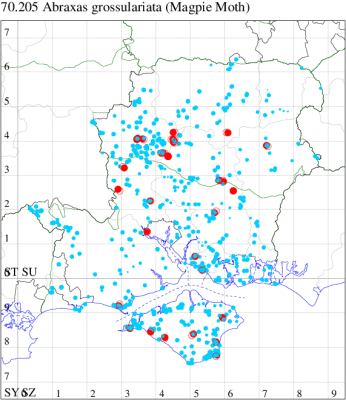
Records by year
Records by week (adult)
Records by week (larval)
Record Details
VC10: West High Down Quarry, three, 07 Aug; Brook, one, 16 Jul (IOu); Brighstone, two, to actinic, 24 Jun (TDov); Bonchurch, one, 12 Jul; one, 13 Jul (JHa); Rookley, one, to actinic, 22 Jun; one, to actinic, 10 Jul; one, to actinic, 15 Jul; one, to actinic, 17 Jul; one, 21 Jul (JBa); Shanklin, one, 05 Aug; two, 06 Aug; one, 09 Aug (IOu); Broadley Copse, one, to actinic, 25 Jun (JBa);
VC11: Breamore*, one, field observation, 26 Aug (SWan); Lockerley, one, 24 Jun (RJen); Redbridge, one, 28 Jun (WGin); Romsey, one, to actinic, 22 May; one, 12 Aug (NRJ); Broughton, one, to actinic, 06 Aug (GCE); Eastleigh, one, to actinic, 06 Jul; one, to actinic, 07 Aug (KArb); Up Somborne, one, field observation, 07 Jul (CWoo); Locks Heath, one, 13 Jun (PAS); Titchfield Haven NNR, one, 17 Jul (F.M.G.); Hilltop, The Hangers, three, 01 Aug (SI); West Meon, two, 31 Jul (F.M.G.); Northney, Hayling Island, present, 20 Jun (JWP); Petersfield*, one, to actinic, 27 Jul (RAll); Milford on Sea, one, 31 Jul; one, 05 Aug (MMcM);
VC12: Cholderton, one, 10 Jul; three, 24 Jul; two, 08 Aug (TJN, HE); one, field observation, 11 Aug; one, field observation, 22 Aug (TJN, LF); Goodworth Clatford, one, to actinic, 16 Aug; two, to actinic, 16 Aug; one, to actinic, 16 Aug; Wherwell, one, to actinic, 19 Jul; Chilbolton, one, to actinic, 14 Jul; one, to actinic, 14 Jul; one, to actinic, 14 Jul; Crawley, one, to actinic, 12 Aug; two, to actinic, 12 Aug; Barton Stacey, one, to actinic, 14 Aug (GCE); Harestock, one, to actinic, 26 Jun; one, to actinic, 24 Jul (GRog); Barton Stacey, one, to actinic, 12 Jul; one, to actinic, 11 Aug; one, to actinic, 14 Aug; one, to actinic, 12 Jul (GCE); Cheriton, one, to actinic, 07 Aug (DAS); Hinton Ampner, one, indoors, 10 Aug (ASD); Preston Candover, one, 07 Aug (MJW); Alton, one, to actinic, 14 Jul (NDP)
70.207 [B&F: 1887] Clouded Border Lomaspilis marginata (Linnaeus, 1758) - Common
Common in woodland, marshes, river-banks and heathland throughout the British Isles. Widespread and common in Hampshire and on the Isle of Wight. Wingspan 24-28 mm. Unmistakable. Larva feeds on Aspen, Poplar, Sallow, Willow and Hazel, over-wintering as a pupa.
Records prior to 2020
| Vice County | #Records | #Individuals | First Record | Last Record |
|---|---|---|---|---|
| 10 | 893 | 3072 | 1972 | 2019 |
| 11 | 7144 | 12693 | 1900 | 2019 |
| 12 | 2528 | 6181 | 1951 | 2019 |
2020 records
| Vice County | #Records | #Individuals | Max Quantity |
|---|---|---|---|
| 10 | 54 | 139 | 31 |
| 11 | 280 | 456 | 12 |
| 12 | 136 | 215 | 7 |
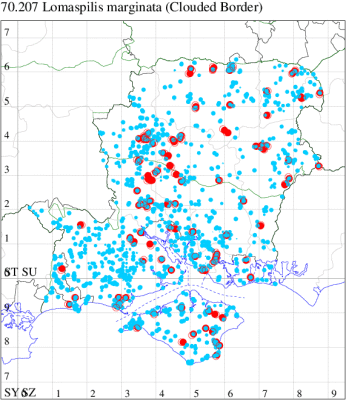
Records by year
Records by week (adult)
Records by week (larval)
Record Summary
VC10: Earliest: Freshwater Cliffs, 11 May, 1 (SDa) Latest: Firestone Copse, 21 Jul, 4 (IOu) Max count: Haseley Manor, 09 Jun, 31 (IOu)
VC11: Earliest: Brockwood, 13 Jun, 1 (SDut) Latest: Pennington, 10 Aug, 1 (RFC) Max count: Stockbridge Down NT, 19 Jun, 12 (GCE)
VC12: Earliest: Cholderton, 10 Jul, 1 (TJN, HE) Latest: Yateley, 23 Jun, 2 (JHH) Max count: Pamber Forest, 28 May, 7 (GJD)
70.208 [B&F: 1888] Scorched Carpet Ligdia adustata ([Denis & Schiffermüller], 1775) - Local
Local in broad-leaved woodland, scrub, hedgerows and gardens throughout much of southern England, especially where there are calcareous soils. In Hampshire and on the Isle of Wight widely distributed, mainly on the chalk but also in the New Forest, and in gardens. Wingspan 25-30 mm. Unmistakable. Larva feeds on Spindle, and on Evergreen Spindle in gardens, over-wintering as a pupa.
Records prior to 2020
| Vice County | #Records | #Individuals | First Record | Last Record |
|---|---|---|---|---|
| 10 | 380 | 471 | 1977 | 2019 |
| 11 | 1624 | 1798 | 1951 | 2019 |
| 12 | 946 | 996 | 1951 | 2019 |
2020 records
| Vice County | #Records | #Individuals | Max Quantity |
|---|---|---|---|
| 10 | 15 | 28 | 8 |
| 11 | 72 | 82 | 4 |
| 12 | 68 | 79 | 3 |
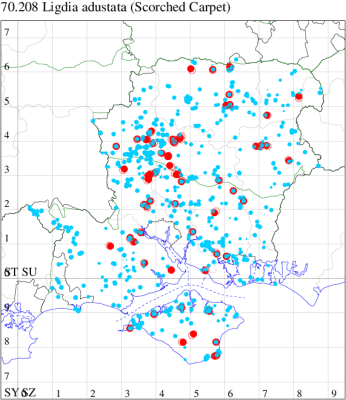
Records by year
Records by week (adult)
Records by week (larval)
Record Summary
VC10: Earliest: West High Down Quarry, 07 Aug, 2 (IOu) Latest: Firestone Copse, 21 Jul, 4 (IOu) Max count: Parkhurst Forest, 28 Jul, 8 (IOu)
VC11: Earliest: Acres Down, 08 Aug, 1 (CWlk) Latest: Petersfield, 04 Aug, 1 (RAll) Max count: West Meon, 31 Jul, 4 (F.M.G.)
VC12: Earliest: Over Wallop, 21 May, 1 (CM) Latest: Fleet, 28 Aug, 1 (MHals) Max count: Chilbolton, 14 Jul, 3 (GCE)
70.211 [B&F: 1889] Peacock Moth Macaria notata (Linnaeus, 1758) - Local
Local in broad-leaved woodland and scrubby heathland throughout much of southern England, north-western England and western Scotland. In Hampshire and on the Isle of Wight fairly common throughout, and often very common in birch woodland. Wingspan 28-32 mm. The main confusion species is Sharp-angled Peacock M. alternata, which see. Larva feeds on Birch and Sallow, over-wintering as a pupa.
Records prior to 2020
| Vice County | #Records | #Individuals | First Record | Last Record |
|---|---|---|---|---|
| 10 | 59 | 39 | 1978 | 2018 |
| 11 | 1050 | 1209 | 1951 | 2019 |
| 12 | 457 | 694 | 1951 | 2019 |
2020 records
| Vice County | #Records | #Individuals | Max Quantity |
|---|---|---|---|
| 10 | 5 | 4 | 1 |
| 11 | 40 | 57 | 4 |
| 12 | 21 | 25 | 4 |
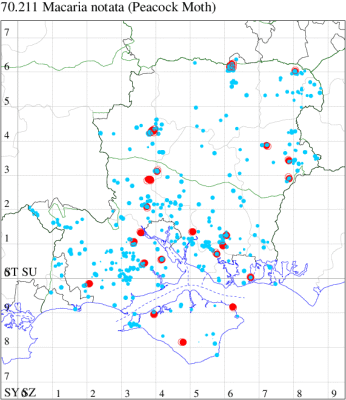
Records by year
Records by week (adult)
Records by week (larval)
Record Details
VC10: Cranmore, present, to actinic, 12 Aug (CHic); Kingston, one, 22 Jul; one, 29 Jul; one, 01 Aug (ENes); Seaview, one, to lighted window, 18 Aug (JMas);
VC11: Culverley, NF, two, 19 Jul (CL); Ashurst, NF, one, 03 May; one, 08 Aug; two, 10 Aug (SAB); Totton, one, 07 Aug (LH); Romsey, one, 11 Aug (MB); Kings Somborne, one, to actinic, 11 Jun; one, to actinic, 11 Jun; one, to actinic, 31 Jul; one, to actinic, 11 Jun; three, to actinic, 31 Jul; four, to actinic, 21 May; three, to actinic, 31 Jul (GCE); Dibden Purlieu, one, to actinic, 11 Aug; one, to actinic, 14 Aug (RAC); Eastleigh, one, to actinic, 31 Jul (KArb); Kings Somborne, one, to actinic, 26 May (GCE); Fareham, one, 12 Aug (KJW); Wickham, one, 07 Aug (F.M.G.); Botley, one, to actinic, 10 Aug (SLB); Wickham, one, 23 Jul; one, 24 Jul; one, 01 Aug; one, 02 Aug; one, 07 Aug; one, 08 Aug; four, 09 Aug; three, 10 Aug; two, 11 Aug; one, 14 Aug; one, 22 Aug (JRDS); Portsmouth, one, 11 Jul (IRT); West Walk, four, 14 Aug (F.M.G.); Northney, Hayling Island, present, 14 Aug (JWP); Bransgore, NF, one, to actinic, 29 Jul (JHC);
VC12: Anna Valley, Andover, one, 07 Aug (TJN); Harewood Forest, one, to actinic, 23 May; one, to actinic, 23 Jul; one, to actinic, 23 Jul (GCE); Pamber Forest, one, 06 Aug (GJD); Broadmoor Bottom, Silchester, one, 15 Jun (JLe); Pamber Forest, one, 20 May; one, 08 Jun; one, 23 Jun; one, 31 Jul; two, 10 Aug; one, 15 Aug (GJD); Liss Forest, one, 06 Jun; one, 18 Jul; four, 15 Aug (RJM); Alton, one, to actinic, 16 Jun (NDP); Whitehill, one, to actinic, 27 May; one, to actinic, 30 May; two, to actinic, 15 Aug (ASto); Yateley, one, 17 Aug (JHH)
70.212 [B&F: 1890] Sharp-angled Peacock Macaria alternata ([Denis & Schiffermüller], 1775) - Local
Local in broad-leaved woodland, scrubby heathland and sand-dunes throughout much of England, more commonly in the south. In Hampshire and on the Isle of Wight fairly common throughout, being the rather more common of the two similar Macaria species. Wingspan 27-32 mm. The main confusion species is Peacock Moth M. notata, but in M. alternata there is usually an indistinct grey band running through the blotch in the centre of the forewing, across both forewing and hindwing, and the apical markings are bolder, accentuating the more pointed apex and deeper notch in the termen. Larva feeds on Sallow, Blackthorn, Sea Buckthorn and Alder, over-wintering as a pupa.
Records prior to 2020
| Vice County | #Records | #Individuals | First Record | Last Record |
|---|---|---|---|---|
| 10 | 496 | 760 | 1943 | 2019 |
| 11 | 4594 | 7026 | 713 | 2019 |
| 12 | 673 | 1062 | 1951 | 2019 |
2020 records
| Vice County | #Records | #Individuals | Max Quantity |
|---|---|---|---|
| 10 | 31 | 68 | 12 |
| 11 | 114 | 157 | 7 |
| 12 | 23 | 41 | 4 |
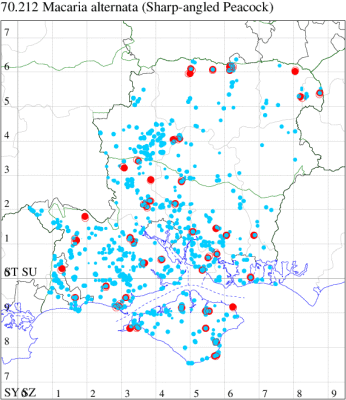
Records by year
Records by week (adult)
Records by week (larval)
Record Summary
VC10: Earliest: West High Down Quarry, 07 Aug, 2 (IOu) Latest: Seaview, 18 Jul, 1 (JMas) Max count: Haseley Manor, 11 Aug, 12 (IOu)
VC11: Earliest: Brockwood, 07 Aug, 1 (SDut) Latest: Pennington, 29 May, 1 (RFC) Max count: Wickham, 11 Aug, 7 (JRDS)
VC12: Earliest: Cholderton, 08 Aug, 2 (TJN, HE) Latest: Yateley, 26 May, 1 (JHH) Max count: Fleet, 06 Aug, 4 (AGi)
70.214 [B&F: 1893] Tawny-barred Angle Macaria liturata (Clerck, 1759) - Common
Common in coniferous woodland, plantations and gardens throughout the British Isles. Widespread and common in Hampshire and on the Isle of Wight. Wingspan 28-34 mm. Worn specimens could be misidentified as Dusky Peacock M. signaria, an extremely rare immigrant, which see. Larva feeds on various coniferous trees, including Scots Pine and Norway Spruce, over-wintering as a pupa.
Records prior to 2020
| Vice County | #Records | #Individuals | First Record | Last Record |
|---|---|---|---|---|
| 10 | 92 | 68 | 1856 | 2019 |
| 11 | 2612 | 2924 | 1951 | 2019 |
| 12 | 788 | 1264 | 1951 | 2019 |
2020 records
| Vice County | #Records | #Individuals | Max Quantity |
|---|---|---|---|
| 10 | 1 | 1 | 1 |
| 11 | 109 | 152 | 6 |
| 12 | 73 | 123 | 6 |
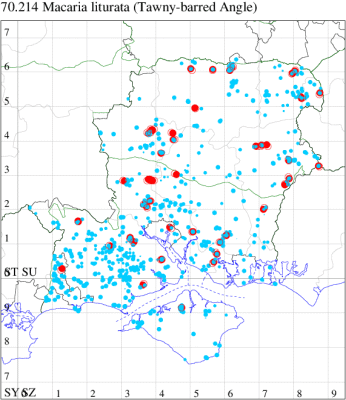
Records by year
Records by week (adult)
Records by week (larval)
Record Summary
VC10: Earliest: Parkhurst Forest, 29 Jun, 1 (IOu) Max count: Parkhurst Forest, 29 Jun, 1 (IOu)
VC11: Earliest: Brockwood, 23 May, 1 (SDut) Latest: Norleywood, NF, 09 Aug, 0 (RBW, MWa) Max count: Brockwood, 14 Aug, 6 (SDut)
VC12: Earliest: Goodworth Clatford, 24 Jun, 1 (GCE) Latest: Yateley, 17 Aug, 2 (JHH) Max count: Liss Forest, 15 Aug, 6 (RJM)
70.218 [B&F: 1894] Latticed Heath Chiasmia clathrata (Linnaeus, 1758) - Ireland only
Common in farmland, gardens, calcareous grassland, acid heathland and moorland throughout most of the British Isles, a species of conservation concern under the UK Biodiversity Action Plan. In Hampshire and on the Isle of Wight quite common on the chalk and in waste places with clover, and also found in clover crops. Wingspan 26-32 mm. Flies both by day, in warm sunshine, and at night. Although distinctive, it has been confused with Common Heath Ematurga atomaria, but only Latticed Heath has such conspicuous, black veins; there is a confusing black form alboguttata, which is best distinguished by the chequered fringes. Larva feeds on Hare's-foot Clover, White Clover, Red Clover, Bird's-foot Trefoil and Lucerne, over-wintering as a pupa.
Records prior to 2020
| Vice County | #Records | #Individuals | First Record | Last Record |
|---|---|---|---|---|
| 10 | 26 | 11 | 1951 | 2019 |
| 11 | 135 | 122 | 1945 | 2018 |
| 12 | 132 | 110 | 1951 | 2018 |
2020 records
| Vice County | #Records | #Individuals | Max Quantity |
|---|---|---|---|
| 10 | 3 | 3 | 1 |
| 11 | 7 | 7 | 2 |
| 12 | 3 | 3 | 1 |
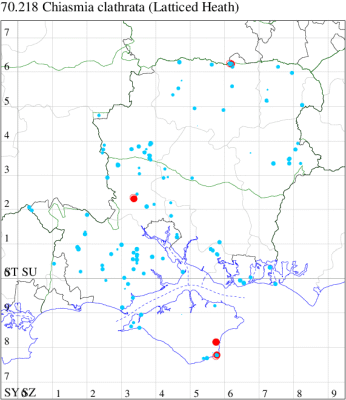
Records by year
Records by week (adult)
Records by week (larval)
Record Details
VC10: Bonchurch, one, 19 Aug; one, 27 Aug (JHa); Shanklin, one, 26 Aug (IOu);
VC11: Rockford Common, two, field observation, 07 Jun (BWT); Roe South, one, field observation, 20 May (CHol); Roydon Woods HWT Reserve, one, field observation, 24 Jun (KBro); Pignal Inclosure, NF, one, field observation, 20 May (SRan); Stanbrige Earls, one, field observation, 21 May (JRMi); Northney, Hayling Island, present, 19 Aug (JWP);
VC12: Pamber Heath, one, field observation, 15 Jun (DLev); Hawley Common, Blackwater, one, field observation, 19 May (SEas)
70.221 [B&F: 1901] Little Thorn Cepphis advenaria (Hübner, 1790) - Nationally Scarce
Nationally scarce (Nb) in open woodland, woodland rides and scrub in southern England (Hampshire and adjoining counties) and from north Somerset up through Gloucestershire and Monmouthshire into Herefordshire, with a few isolated populations elsewhere in England and southern Ireland. In Hampshire and on the Isle of Wight local but quite frequent in many woodland localities. Wingspan 27-30 mm. Small size renders this 'thorn' fairly unmistakable. Larva feeds on Bramble, in neutral or basic habitats, or Bilberry in those which are acid, over-wintering as a pupa.
Records prior to 2020
| Vice County | #Records | #Individuals | First Record | Last Record |
|---|---|---|---|---|
| 10 | 157 | 176 | 1800 | 2019 |
| 11 | 436 | 455 | 1800 | 2019 |
| 12 | 102 | 180 | 1900 | 2019 |
2020 records
| Vice County | #Records | #Individuals | Max Quantity |
|---|---|---|---|
| 10 | 15 | 22 | 3 |
| 11 | 12 | 12 | 1 |
| 12 | 2 | 2 | 1 |
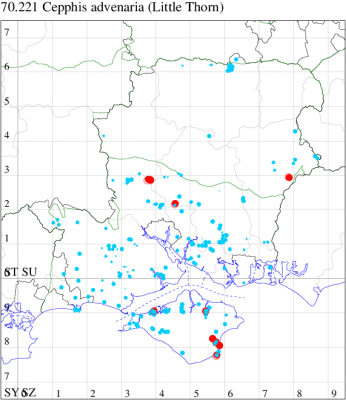
Records by year
Records by week (adult)
Records by week (larval)
Record Details
VC10: Cranmore, one, field observation, 30 May (KNow); Bonchurch, one, 02 May; one, 25 Jun (JHa); America Wood, two, at dusk, 18 May; Shanklin, two, 09 May; one, 12 May; one, 17 May; two, 21 May; one, 25 May; three, 26 May; one, 28 May; two, 30 May; one, 02 Jun; Shanklin Upper Chine, one, 25 May; Sandpit Copse, two, 20 May (IOu);
VC11: Kings Somborne, one, to actinic, 21 May; one, to actinic, 21 May; one, to actinic, 21 May (GCE); Eastleigh, one, to actinic, 20 May (KArb); Allbrook, one, 21 May (SI); Wickham, one, 08 May; one, 19 May; one, 25 May (JRDS); Sway, one, 23 May (SKe);
VC12: Warren Hill, Liss Forest, one, field observation, 25 May; one, 14 Jun (RJM)
70.222 [B&F: 1902] Brown Silver-line Petrophora chlorosata (Scopoli, 1763) - Common
Common wherever there is bracken, in woodland, heathland and moorland throughout much of the British Isles. In Hampshire and on the Isle of Wight extremely common amongst bracken everywhere - in fact one of the few species of insect that feeds on this plant. Well-recorded as it is easily disturbed by day. Wingspan 31-37 mm. Fairly unmistakable. Larva feeds on Bracken, over-wintering as a pupa.
Records prior to 2020
| Vice County | #Records | #Individuals | First Record | Last Record |
|---|---|---|---|---|
| 10 | 188 | 236 | 1951 | 2019 |
| 11 | 3784 | 8636 | 1951 | 2019 |
| 12 | 822 | 2455 | 1951 | 2019 |
2020 records
| Vice County | #Records | #Individuals | Max Quantity |
|---|---|---|---|
| 10 | 26 | 38 | 4 |
| 11 | 184 | 287 | 9 |
| 12 | 57 | 114 | 16 |
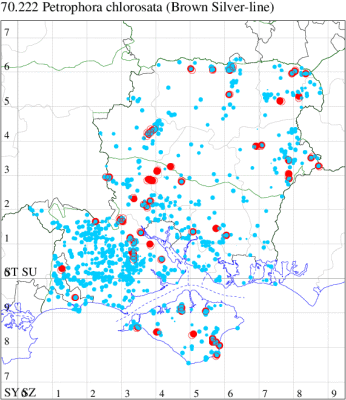
Records by year
Records by week (adult)
Records by week (larval)
Record Summary
VC10: Earliest: Freshwater Cliffs, 16 May, 1 (SDa) Latest: Briddlesford Big Wood, Wootton Bridge, 20 May, 1 (IOu) Max count: Parkhurst Forest, 29 Jun, 4 (IOu)
VC11: Earliest: Brockwood, 26 Apr, 1 (SDut) Latest: Lepe, 16 Jun, 1 (MSmi) Max count: Kings Somborne, 21 May, 9 (GCE)
VC12: Earliest: Anna Valley, Andover, 26 May, 1 (TJN) Latest: Yateley, 23 Jun, 1 (JHH) Max count: Pamber Forest, 30 May, 16 (GJD)
70.223 [B&F: 1903] Barred Umber Plagodis pulveraria (Linnaeus, 1758) - Local
Local in ancient broad-leaved woodland and on limestone pavements throughout much of the British Isles. In Hampshire and on the Isle of Wight widely distributed but somewhat scarce, in surviving areas of mature deciduous woodland. Wingspan 32-38 mm. Fairly unmistakable. Larva feeds on Hazel, Downy Birch, Silver Birch, Sallow and Hawthorn, over-wintering as a pupa.
Records prior to 2020
| Vice County | #Records | #Individuals | First Record | Last Record |
|---|---|---|---|---|
| 10 | 21 | 16 | 1856 | 2019 |
| 11 | 193 | 158 | 1940 | 2019 |
| 12 | 78 | 55 | 1951 | 2019 |
2020 records
| Vice County | #Records | #Individuals | Max Quantity |
|---|---|---|---|
| 10 | 1 | 2 | 2 |
| 11 | 4 | 6 | 3 |
| 12 | 2 | 2 | 1 |
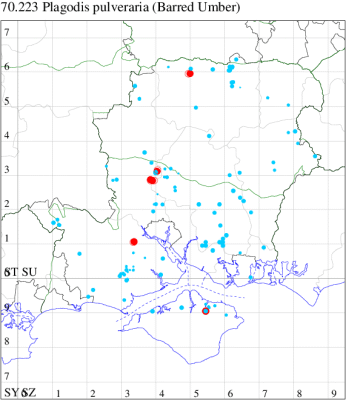
Records by year
Records by week (adult)
Records by week (larval)
Record Details
VC10: Sandpit Copse, two, 20 May (IOu);
VC11: Ashurst, NF, one, 07 May (SAB); Kings Somborne, one, to actinic, 21 May; Hursley, three, to actinic, 21 May; Kings Somborne, one, to actinic, 26 May (GCE);
VC12: Ecchinswell*, one, to actinic, 07 May (MTa, CSu); Ropley, one, 26 May (TJN, LF)
70.224 [B&F: 1904] Scorched Wing Plagodis dolabraria (Linnaeus, 1767) - Local
Local in broad-leaved woodland, scrub, parks and gardens throughout the British Isles; widespread and common in Hampshire and the Isle of Wight. Wingspan 34-38 mm. Unmistakable. Larva feeds on Oak, and a number of other deciduous trees, including Downy and Silver Birch, Sallow and Beech, over-wintering as a pupa.
Records prior to 2020
| Vice County | #Records | #Individuals | First Record | Last Record |
|---|---|---|---|---|
| 10 | 436 | 742 | 1979 | 2019 |
| 11 | 3053 | 4936 | 1951 | 2019 |
| 12 | 1027 | 2259 | 1940 | 2019 |
2020 records
| Vice County | #Records | #Individuals | Max Quantity |
|---|---|---|---|
| 10 | 37 | 59 | 4 |
| 11 | 103 | 144 | 8 |
| 12 | 36 | 42 | 3 |
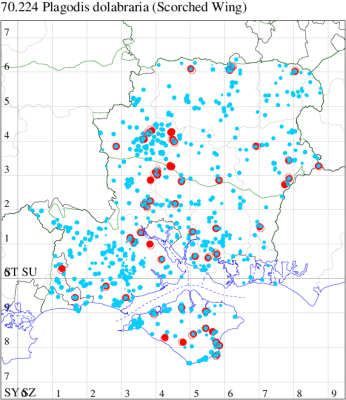
Records by year
Records by week (adult)
Records by week (larval)
Record Summary
VC10: Earliest: Ningwood Common, 21 May, 1 (JMar) Latest: Sandpit Copse, 20 May, 2 (IOu) Max count: Borthwood Copse, Winford, 23 Jun, 4 (IOu)
VC11: Earliest: Brockwood, 27 May, 1 (SDut) Latest: Pennington, 17 Jun, 1 (RFC) Max count: Kings Somborne, 26 May, 8 (GCE)
VC12: Earliest: Over Wallop, 16 May, 1 (CM) Latest: Yateley, 26 May, 1 (JHH) Max count: Goodworth Clatford, 23 May, 3 (GCE)
70.225 [B&F: 1905] Horse Chestnut Pachycnemia hippocastanaria (Hübner, [1799]) - Nationally Scarce
Nationally scarce (Nb) in heathland in southern England (Hampshire and adjoining counties). In Hampshire a characteristic species of the heathlands of the New Forest and north-east Hampshire, and occasionally recorded elsewhere in the county and along the north-western coast of the Isle of Wight. Wingspan 28-32 mm. Fairly unmistakable. Larva feeds on Heather and Cross-leaved Heath, over-wintering as a pupa.
Records prior to 2020
| Vice County | #Records | #Individuals | First Record | Last Record |
|---|---|---|---|---|
| 10 | 12 | 8 | 1930 | 2014 |
| 11 | 1076 | 1558 | 1800 | 2019 |
| 12 | 149 | 212 | 1900 | 2019 |
2020 records
| Vice County | #Records | #Individuals | Max Quantity |
|---|---|---|---|
| 11 | 17 | 23 | 4 |
| 12 | 10 | 9 | 2 |
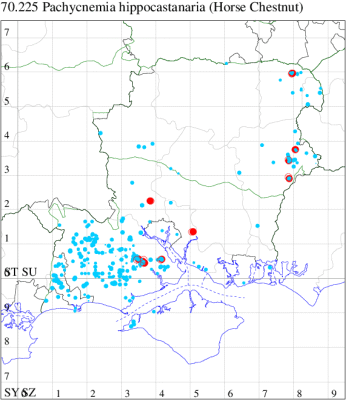
Records by year
Records by week (adult)
Records by week (larval)
Record Details
VC11: Shatterford, NF, one, 14 Jul; present, 14 Jul (RBW, MWa); Pig Bush, NF, one, 17 Jul; four, 18 Jul; Culverley, NF, three, 19 Jul (CL); Romsey, one, 25 Jul (NRJ); Dibden Purlieu, one, to actinic, 26 Jun; one, to actinic, 18 Jul; one, to actinic, 23 Jul; two, to actinic, 24 Jul; one, 22 Sep (RAC); Botley*, one, to actinic, 12 Aug (SLB);
VC12: Liss Forest, two, 13 Apr; one, 18 Jul (RJM); Whitehill, one, to actinic, 17 Aug; one, 15 Sep; one, 21 Sep (ASto); Castle Bottom NNR, one, netted, 15 Jun (JHH); present, 25 Jun (JHH, AMD); Broxhead Common, one, field observation, 26 Jun (KBW); Headley, Bordon, present, 23 Jul (iNat)
70.226 [B&F: 1906] Brimstone Moth Opisthograptis luteolata (Linnaeus, 1758) - Common
Common in hedgerows, gardens, woodland, calcareous grassland and acid heathland throughout the British Isles; abundant throughout Hampshire and on the Isle of Wight. Wingspan 33-46 mm. Unmistakable, one of the commonest and most well-recorded geometers in the country. Larva feeds on Blackthorn, Hawthorn, Midland Hawthorn, Rowan and Wayfaring-tree, over-wintering as a pupa or small larva.
Records prior to 2020
| Vice County | #Records | #Individuals | First Record | Last Record |
|---|---|---|---|---|
| 10 | 2129 | 6284 | 1951 | 2019 |
| 11 | 23381 | 55709 | 200 | 2019 |
| 12 | 6880 | 18197 | 1951 | 2019 |
2020 records
| Vice County | #Records | #Individuals | Max Quantity |
|---|---|---|---|
| 10 | 193 | 1053 | 100 |
| 11 | 1271 | 2860 | 35 |
| 12 | 521 | 1165 | 18 |
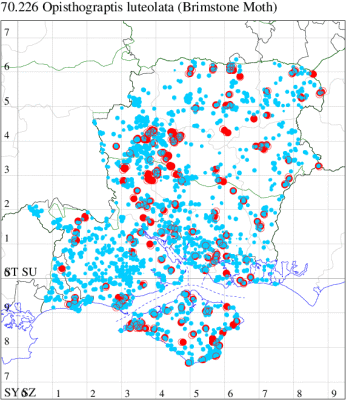
Records by year
Records by week (adult)
Records by week (larval)
Record Summary
VC10: Earliest: West High Down Quarry, 07 Aug, 100 (IOu) Latest: Ryde, 03 Sep, 4 (IPra) Max count: West High Down Quarry, 07 Aug, 100 (IOu)
VC11: Earliest: Brockwood, 23 May, 1 (SDut) Latest: Southsea, 21 May, 1 (JRL) Max count: Milford on Sea, 07 Aug, 35 (MMcM)
VC12: Earliest: Over Wallop, 23 Apr, 3 (CM) Latest: Yateley, 08 Sep, 1 (JHH) Max count: Cholderton, 11 Aug, 18 (TJN, LF)
70.227 [B&F: 1907] Bordered Beauty Epione repandaria (Hufnagel, 1767) - Common
Common in damp woodland rides and clearings, scrub, hedgerows and gardens throughout the British Isles. In Hampshire and on the Isle of Wight there have been relatively few recent records of this inhabitant of damp sallow thickets. Wingspan 28-31 mm. The main confusion species is Dark Bordered Beauty E. vespertaria, which differs chiefly in the distal edge of the subterminal fascia, which is parallel with the dorsum in E. vespertaria, but which meets the apex in E. repandaria. Larva feeds on Sallow, Black Poplar, Alder and Hazel, over-wintering as an egg.
Records prior to 2020
| Vice County | #Records | #Individuals | First Record | Last Record |
|---|---|---|---|---|
| 10 | 124 | 161 | 1955 | 2019 |
| 11 | 1309 | 1292 | 1951 | 2019 |
| 12 | 195 | 162 | 1951 | 2019 |
2020 records
| Vice County | #Records | #Individuals | Max Quantity |
|---|---|---|---|
| 10 | 10 | 11 | 2 |
| 11 | 19 | 18 | 2 |
| 12 | 6 | 6 | 1 |
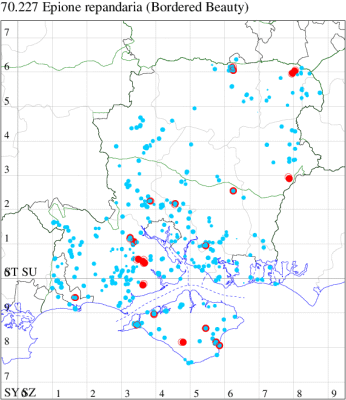
Records by year
Records by week (adult)
Records by week (larval)
Record Details
VC10: Afton Marsh, two, to actinic, 28 Sep (IOu); Cranmore, present, to actinic, 20 Jul (CHic); Kingston, one, 22 Jun; two, 24 Jun (ENes); Haseley Manor, one, 06 Jul; Shanklin, one, 05 Aug; one, 16 Aug; one, 12 Sep; one, 15 Sep; Shanklin Upper Chine, one, 31 Jul (IOu);
VC11: Shatterford, NF, one, 14 Jul (RBW, MWa); Pig Bush, NF, one, 17 Jul; Culverley, NF, one, 19 Jul (CL); Woodlands, New Forest, present, 25 Jun (RBW); Ashurst, NF, one, 07 Aug (SAB); Romsey, one, 22 Sep (NRJ); Eastleigh, one, to actinic, 09 Aug (KArb); Allbrook, one, 30 Jul (SI); Botley Wood, one, field observation, 18 Sep (F.M.G.); Wickham, one, 01 Jul; one, 11 Aug; one, 23 Aug; one, 15 Sep (JRDS); West Meon, two, 31 Jul (F.M.G.); Petersfield*, one, to actinic, 08 Jul; Stroud, Petersfield*, one, to actinic, 09 Jul; Petersfield*, one, to actinic, 27 Jul; Stroud, Petersfield*, two, to actinic, 31 Jul (RAll); Burton, nr Christchurch, one, 31 Jul (JSw); Norleywood, NF, present, 09 Aug (RBW, MWa);
VC12: Pamber Forest, one, 06 Aug; one, 10 Aug; one, 07 Sep (GJD); Liss Forest*, one, 08 Aug (RJM); Castle Bottom NNR, one, 16 Aug; Yateley, one, 13 Aug (JHH)
70.229 [B&F: 1909] Speckled Yellow Pseudopanthera macularia (Linnaeus, 1758) - Common
Common in open woodland, scrubland and grassland throughout the British Isles. In Hampshire and on the Isle of Wight especially common away from the chalk in such areas as the New Forest, Harewood Forest, Pamber Forest, Odiham Common Broxhead Common Botley Wood and Ampfield Wood. Wingspan 28-30 mm. An unmistakable day-flying moth. Larva feeds on Wood Sage, over-wintering as a pupa.
Records prior to 2020
| Vice County | #Records | #Individuals | First Record | Last Record |
|---|---|---|---|---|
| 10 | 197 | 262 | 1900 | 2019 |
| 11 | 827 | 2820 | 1951 | 2019 |
| 12 | 1021 | 2713 | 1951 | 2019 |
2020 records
| Vice County | #Records | #Individuals | Max Quantity |
|---|---|---|---|
| 10 | 2 | 2 | 1 |
| 11 | 38 | 112 | 10 |
| 12 | 31 | 44 | 4 |
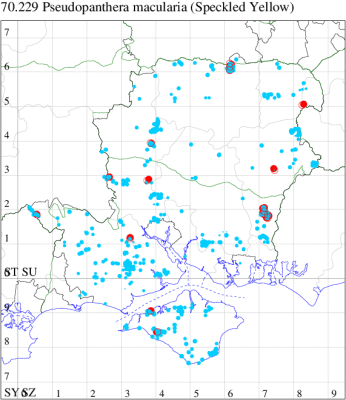
Records by year
Records by week (adult)
Records by week (larval)
Record Details
VC10: Bouldnor, one, field observation, on Gorse Bushes , 06 May (KNow det. JBa); Brook, one, field observation, 21 May (KShw);
VC11: Roe South, one, field observation, 20 May (CHol); Holmsley Inclosure, New Forest, two, field observation, 21 May (TBum); Bentley Wood, five, field observation, 26 May (A&LB); two, 21 May (NPa); Pignal Inclosure, NF, one, field observation, 20 May (SRan); Woodlands, New Forest, present, 08 May (RBW); Kings Somborne, one, to actinic, 21 May (GCE); Ampfield Wood, one, field observation, 30 May (T&SGra); St Catherine's Hill, Winchester, one, field observation, 20 May; one, field observation, 27 May (CPia); Havant, one, field observation, 13 Jun (SDaw); Queen Elizabeth CP, eight, field observation, 18 May; 10, field observation, 26 May (SJD); Windmill Hill, Chalton, one, field observation, 18 Sep (S&SDen); Queen Elizabeth CP, one, field observation, 14 May; one, field observation, 26 May; 10, field observation, 03 Jun (SJD); Windmill Hill, Chalton, one, field observation, 20 Jul (S&SDen); Queen Elizabeth CP, one, field observation, 24 Jun; two, field observation, 28 May; one, field observation, 07 Jun; three, field observation, 20 May; two, field observation, 24 May; one, field observation, 31 May (SJD); Butser Hill, four, field observation, 30 May (JGe); Queen Elizabeth CP, five, field observation, 17 May (SJD);
VC12: Martin Down NNR, three, field observation, 25 May (DKel); West Down, Chilbolton, one, field observation, 08 May (GCE); Pamber Forest, one, field observation, 18 May; one, field observation, 07 May; one, field observation, 04 May; one, field observation, 14 May; two, field observation, 08 May; one, field observation, 07 May; one, field observation, 07 May; one, field observation, 18 May; Silchester Common, two, field observation, 08 May (GJD); Noar Hill, one, field observation, 26 Apr (BCA); Broxhead Common, one, field observation, 30 May; Bramshott Common, three, field observation, 07 May; one, field observation, 20 May; one, field observation, 18 May; one, field observation, 20 May; one, field observation, 18 May; two, field observation, 20 May; two, field observation, 31 May; two, field observation, 18 May; one, field observation, 31 May; one, field observation, 13 Jun; one, field observation, 18 May; one, field observation, 20 May; one, field observation, 18 May; two, field observation, 05 May; two, field observation, 07 May; two, field observation, 18 May; four, field observation, 20 May; one, field observation, 31 May (AGre); Aldershot, one, field observation, 24 May (MHals)
70.230 [B&F: 1924] Orange Moth Angerona prunaria (Linnaeus, 1758) - Local
Local in broad-leaved woodland, scrubby heathland and mature hedgerows, throughout southern England; although still quite common in Hampshire and the Isle of Wight in a few mature woodlands, it is has disappeared from a number of former haunts. Wingspan 42-56 mm. Unmistakable, although somewhat variable. Larva feeds on various woody plants, including Blackthorn, Hawthorn, Birch, Heather, Broom and Traveller's-joy.
Records prior to 2020
| Vice County | #Records | #Individuals | First Record | Last Record |
|---|---|---|---|---|
| 10 | 44 | 109 | 1800 | 2019 |
| 11 | 317 | 666 | 1951 | 2019 |
| 12 | 76 | 154 | 1900 | 2019 |
2020 records
| Vice County | #Records | #Individuals | Max Quantity |
|---|---|---|---|
| 10 | 1 | 2 | 2 |
| 11 | 17 | 17 | 1 |
| 12 | 2 | 8 | 6 |
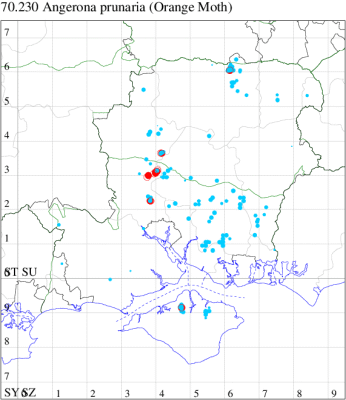
Records by year
Records by week (adult)
Records by week (larval)
Record Details
VC10: Parkhurst Forest, two, 29 Jun (IOu);
VC11: Ashley, one, to actinic, 23 Jun (GCE); Romsey, one, 08 Jun; one, 15 Jun; one, to actinic, 23 Jun; one, 24 Jun (NRJ); Kings Somborne, one, to actinic, 26 May; one, to actinic, 15 Jun; one, to actinic, 15 Jun; one, to actinic, 15 Jun; one, to actinic, 15 Jul; one, to actinic, f. corylaria, 26 May; one, to actinic, 15 Jun (GCE); Wickham, one, 01 Jun; one, 07 Jun; one, 17 Jun; one, 21 Jun (JRDS); Lovedean, one, 13 Jun (ARJ);
VC12: Chilbolton, two, to actinic, 16 Jun (GCE); Pamber Forest, six, 30 May (GJD)
70.231 [B&F: 1910] Lilac Beauty Apeira syringaria (Linnaeus, 1758) - Local
Local in broad-leaved woodland, scrub and gardens throughout much of England, Wales and southern Scotland. In Hampshire and on the Isle of Wight widespread and not uncommon throughout, but thinly distributed and occurring only in small numbers. Wingspan 38-42 mm. Unmistakable. Larva feeds on Honeysuckle, Ash, Wild Privet and Garden Privet.
Records prior to 2020
| Vice County | #Records | #Individuals | First Record | Last Record |
|---|---|---|---|---|
| 10 | 73 | 48 | 1930 | 2019 |
| 11 | 498 | 383 | 1945 | 2019 |
| 12 | 221 | 170 | 1940 | 2019 |
2020 records
| Vice County | #Records | #Individuals | Max Quantity |
|---|---|---|---|
| 10 | 1 | 1 | 1 |
| 11 | 6 | 6 | 1 |
| 12 | 6 | 5 | 1 |
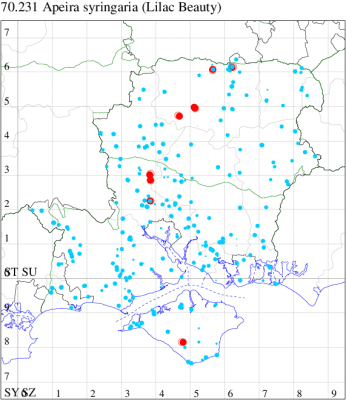
Records by year
Records by week (adult)
Records by week (larval)
Record Details
VC10: Kingston, one, 17 Jun (ENes);
VC11: Romsey, one, 16 Jun (NRJ); Kings Somborne, one, to actinic, 11 Jun; Ashley, one, to actinic, 23 Jun (GCE); Wickham, one, 15 Jun (JRDS); Lovedean, one, 15 Jun (ARJ); Sway, one, 01 Jun (SKe);
VC12: Whitchurch, one, 17 Sep (SBr); Overton, one, field observation, 16 Jun (B&ME); one, 22 Sep (MSi); Axmansford, one, to lighted window, 17 Jun (ACB); Pamber Forest, one, 13 Jul (GJD); Headley, Bordon, present, 09 Sep (iNat)
70.233 [B&F: 1912] August Thorn Ennomos quercinaria (Hufnagel, 1767) - Local
Local in woodland, parks, hedgerows, scrubby downland and gardens throughout England and Wales, a species of conservation concern under the UK Biodiversity Action Plan. Widely distributed, but perhaps decreasing, in Hampshire and the Isle of Wight. Wingspan 42-50 mm. Probably easier to confuse with Dusky Thorn E. fuscantaria than September Thorn E. erosaria, which see, since a good proportion of August Thorn show dark shading between outer cross-line and outer edge of wing, the stated diagnostic feature for Dusky Thorn; the three species all show subtle differences in the way the outer cross-line meets the costa. Larva feeds on Pedunculate and Sessile Oak, over-wintering as an egg.
Records prior to 2020
| Vice County | #Records | #Individuals | First Record | Last Record |
|---|---|---|---|---|
| 10 | 102 | 118 | 1856 | 2019 |
| 11 | 597 | 614 | 1951 | 2019 |
| 12 | 266 | 274 | 1940 | 2019 |
2020 records
| Vice County | #Records | #Individuals | Max Quantity |
|---|---|---|---|
| 10 | 4 | 4 | 1 |
| 11 | 31 | 39 | 3 |
| 12 | 16 | 19 | 4 |
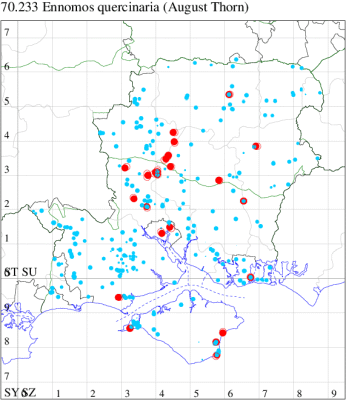
Records by year
Records by week (adult)
Records by week (larval)
Record Details
VC10: West High Down Quarry, one, 20 Aug (IOu); Bonchurch, one, 10 Aug (JHa); Shanklin, one, 23 Aug (IOu); Sandown, one, to actinic, 10 Aug (JMar);
VC11: Stanbrige Earls, two, to actinic, 13 Aug; two, to actinic, 15 Aug; one, to actinic, 17 Aug; one, to actinic, 08 Sep (JRMi); Romsey, one, 02 Jul (MB); Ashley, one, to actinic, 22 Jul; Broughton, three, to actinic, 06 Aug; Ashley, one, to actinic, 22 Jul; Kings Somborne, one, to actinic, 15 Jul; two, to actinic, 15 Jul; one, to actinic, 07 Aug; one, to actinic, 15 Jul (GCE); Southampton, one, to UV, 20 Jul (JVet); one, to actinic, 12 Jul (MGP); Ashley, one, to actinic, 15 Jul; Kings Somborne, one, to actinic, 15 Jul (GCE); Shirrell Heath, two, 12 Aug; one, 14 Aug (LEdg); Portsmouth, one, 18 Jul; one, 04 Aug; one, 18 Aug (IRT); Hen Wood, two, 24 Jul; one, 04 Sep (F.M.G. det. KJW); Northney, Hayling Island, present, 28 Sep (JWP); Petersfield, one, to actinic, 15 Jul; one, to actinic, 17 Aug; one, to actinic, 20 Aug; Stroud, Petersfield, one, to actinic, 12 Sep (RAll); Everton, one, 29 Jul (MMcM);
VC12: Cholderton, present, 31 Jul (TJN, HE); Anna Valley, Andover, one, 02 Sep (TJN); Crawley, four, 12 Aug (TNo); one, to actinic, 21 Jul; one, to actinic, 21 Jul; one, to actinic, 30 Jul; Barton Stacey, one, to actinic, 14 Aug; one, to actinic, 11 Aug (GCE); Cheriton, one, to actinic, 10 Aug (DAS); Beech, one, 10 Jul; one, 02 Aug (NDP); Basingstoke, one, 07 Jul; one, to actinic, 27 Jul; one, 31 Jul (MJW); Lower Froyle, two, 11 Aug; one, 08 Sep (EFig)
70.234 [B&F: 1913] Canary-shouldered Thorn Ennomos alniaria (Linnaeus, 1758) - Common
Common in woodland, scrub, parks and gardens throughout the British Isles. Widespread and common in Hampshire and on the Isle of Wight. Wingspan 38-42 mm. Larva feeds on Downy and Silver Birch, Alder and Goat Willow.
Records prior to 2020
| Vice County | #Records | #Individuals | First Record | Last Record |
|---|---|---|---|---|
| 10 | 263 | 312 | 1977 | 2019 |
| 11 | 3912 | 4960 | 1951 | 2019 |
| 12 | 862 | 1094 | 1951 | 2019 |
2020 records
| Vice County | #Records | #Individuals | Max Quantity |
|---|---|---|---|
| 10 | 21 | 35 | 6 |
| 11 | 102 | 128 | 7 |
| 12 | 49 | 54 | 2 |
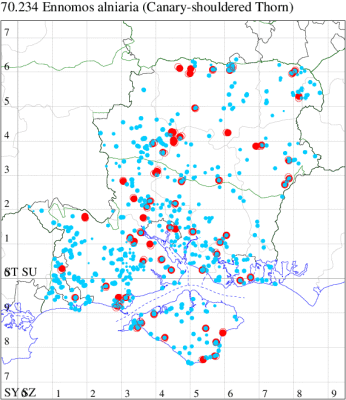
Records by year
Records by week (adult)
Records by week (larval)
Record Summary
VC10: Earliest: Freshwater Cliffs, 16 Jul, 2 (SDa) Latest: Sandown, 10 Aug, 1 (JMar) Max count: Haseley Manor, 11 Aug, 6 (IOu)
VC11: Earliest: Brockwood, 14 Aug, 5 (SDut) Latest: Southsea, 27 Aug, 1 (JGe) Max count: Hale Purlieu, 13 Aug, 7 (MCu)
VC12: Earliest: Chilbolton, 17 Aug, 1 (GCE) Latest: Yateley, 03 Sep, 1 (JHH) Max count: Liss, 31 Jul, 2 (LBe)
70.235 [B&F: 1914] Dusky Thorn Ennomos fuscantaria (Haworth, 1809) - Common
Common in woodland, hedgerows and gardens throughout much of England, a species of conservation concern under the UK Biodiversity Action Plan. In Hampshire and on the Isle of Wight although described as 'common and widespread' in the 2001 county history, this species was identified by a well-publicised long-term Rothamsted survey as having undergone a 98 decline between 1970 and 2005. Looking at the population graph shown below, it would be true to say that the position of Dusky Thorn mirrored the national picture towards the end of the 1990s, but since then, the population seems to have exploded, and it is now found at higher numbers than at any time in the past four decades.
The reason for this increase remains unclear, and although it may perhaps be at least partially explained by greater recording effort since it's plight was revealed, this cannot be the whole story. Wingspan 38-42 mm. The most likely confusion species is August Thorn E. quercinaria, which also often has discal third of forewing darker, but in Dusky Thorn the two median fasciae converge at the dorsum more noticeable than they do in August Thorn, and the postmedian fascia is smoother and less kinked towards the costa in Dusky Thorn. Larva feeds on Ash, over-wintering as an egg.
Records prior to 2020
| Vice County | #Records | #Individuals | First Record | Last Record |
|---|---|---|---|---|
| 10 | 410 | 957 | 1957 | 2019 |
| 11 | 4660 | 8387 | 200 | 2019 |
| 12 | 1176 | 2536 | 1951 | 2019 |
2020 records
| Vice County | #Records | #Individuals | Max Quantity |
|---|---|---|---|
| 10 | 71 | 320 | 19 |
| 11 | 422 | 853 | 16 |
| 12 | 198 | 554 | 21 |
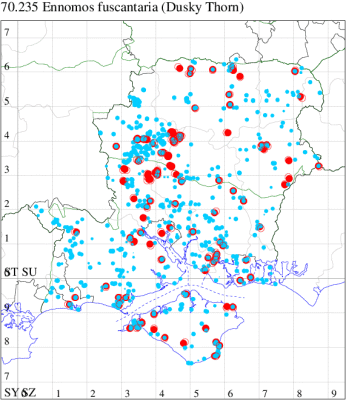
Records by year
Records by week (adult)
Records by week (larval)
Record Summary
VC10: Earliest: West High Down Quarry, 07 Aug, 5 (IOu) Latest: Seaview, 20 Sep, 1 (JMas) Max count: Shanklin, 14 Sep, 19 (IOu)
VC11: Earliest: Ditchend Brook, Newfoundland, NF, 30 Jul, 0 (RBW, MWa) Latest: Southsea, 10 Sep, 1 (JGe) Max count: Stanbrige Earls, 08 Sep, 16 (JRMi)
VC12: Earliest: Over Wallop, 29 Aug, 3 (CM) Latest: Yateley, 17 Aug, 4 (JHH) Max count: Cholderton, 08 Aug, 21 (TJN, HE)
70.236 [B&F: 1915] September Thorn Ennomos erosaria ([Denis & Schiffermüller], 1775) - Common
Common in woodland, parks and gardens throughout much of England, spreading into Scotland, a species of conservation concern under the UK Biodiversity Action Plan. In Hampshire and on the Isle of Wight Common and widespread. Although the flight-time histogram shows a smooth curve of emergence, in most years there are two peaks, one in July and another, usually smaller, in September. Wingspan 38-42 mm. The most likely confusion species is August Thorn E. quercinaria, which has the antemedian fascia (the line nearest the base of the wing) acutely angled at the costa (almost straight in September Thorn). Larva feeds on Oak, Lime, Birch and Beech, over-wintering as an egg.
Records prior to 2020
| Vice County | #Records | #Individuals | First Record | Last Record |
|---|---|---|---|---|
| 10 | 75 | 68 | 1900 | 2019 |
| 11 | 3014 | 5512 | 1949 | 2019 |
| 12 | 554 | 991 | 1951 | 2019 |
2020 records
| Vice County | #Records | #Individuals | Max Quantity |
|---|---|---|---|
| 10 | 7 | 9 | 3 |
| 11 | 245 | 376 | 7 |
| 12 | 64 | 107 | 4 |
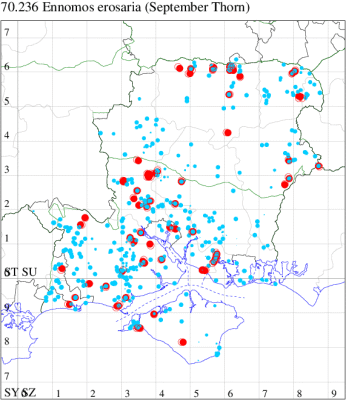
Records by year
Records by week (adult)
Records by week (larval)
Record Summary
VC10: Earliest: Freshwater Bay, 20 Sep, 1 (SDa) Latest: Kingston, 29 Jul, 3 (ENes) Max count: Kingston, 29 Jul, 3 (ENes)
VC11: Earliest: Brockwood, 19 Sep, 1 (SDut) Latest: Pilley Bailey, NF, 03 Aug, 3 (RBW, MWa) Max count: Allbrook, 24 Jun, 6 (SI)
VC12: Earliest: Ecchinswell, 15 Sep, 1 (MTa, CSu) Latest: Yateley, 08 Sep, 4 (JHH) Max count: Ecchinswell, 08 Aug, 4 (MJN)
70.237 [B&F: 1917] Early Thorn Selenia dentaria (Fabricius, 1775) - Common
Common in woodland, scrub, hedgerows, parks and gardens, throughout the British Isles. Wingspan 40-51 mm. The second, summer generation smaller and brighter than the spring generation. Larva feeds on various woody plants, including Blackthorn, Hawthorn, Hazel, Downy and Silver Birch, Alder, Sallow, Honeysuckle and Bog-myrtle, over-wintering as a pupa.
Records prior to 2020
| Vice County | #Records | #Individuals | First Record | Last Record |
|---|---|---|---|---|
| 10 | 737 | 1205 | 1951 | 2019 |
| 11 | 5867 | 7779 | 1951 | 2019 |
| 12 | 1665 | 2323 | 1951 | 2019 |
2020 records
| Vice County | #Records | #Individuals | Max Quantity |
|---|---|---|---|
| 10 | 51 | 84 | 5 |
| 11 | 115 | 129 | 4 |
| 12 | 57 | 64 | 2 |
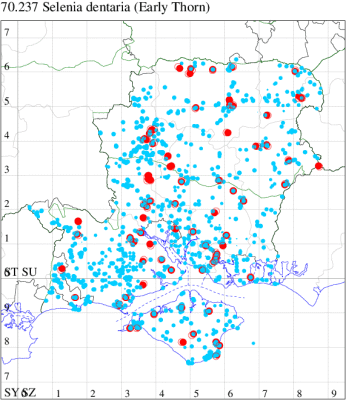
Records by year
Records by week (adult)
Records by week (larval)
Record Summary
VC10: Earliest: West High Down Quarry, 07 Aug, 1 (IOu) Latest: Firestone Copse, 21 Jul, 1 (IOu) Max count: Shanklin, 12 Jul, 5 (IOu)
VC11: Earliest: Brockwood, 26 Apr, 1 (SDut) Latest: Norleywood, NF, 09 Aug, 0 (RBW, MWa) Max count: Allbrook, 12 Apr, 4 (SI)
VC12: Earliest: Cholderton, 10 Jul, 2 (TJN, HE) Latest: Yateley, 31 Jul, 1 (JHH) Max count: Cholderton, 10 Jul, 2 (TJN, HE)
70.239 [B&F: 1919] Purple Thorn Selenia tetralunaria (Hufnagel, 1767) - Common
Common in woodland, scrub, gardens and a wide range of other habitats throughout much of England, spreading into Scotland. In Hampshire and on the Isle of Wight Fairly common and widespread in all three vice-counties. Emerges in two well defined broods, peaking in April and July. Records before 1975 are few, so the graphs shown below are taken from this point forwards. Wingspan 46-52 mm. The most likely confusion species is Lunar Thorn Selenia lunularia, both share the same posture at rest, but Lunar Thorn has the postmedian line straighter, joining the costa closer to the base of the forewing, and lacks the dark spot near the dorsum on the hindwing of Purple Thorn. Larva feeds on various broad-leaved trees, including Hazel, Birch, Alder, Hawthorn and Oak, over-wintering as a pupa.
Records prior to 2020
| Vice County | #Records | #Individuals | First Record | Last Record |
|---|---|---|---|---|
| 10 | 185 | 217 | 1856 | 2019 |
| 11 | 1561 | 1807 | 1951 | 2019 |
| 12 | 714 | 954 | 1951 | 2019 |
2020 records
| Vice County | #Records | #Individuals | Max Quantity |
|---|---|---|---|
| 10 | 5 | 5 | 1 |
| 11 | 76 | 93 | 4 |
| 12 | 37 | 47 | 4 |
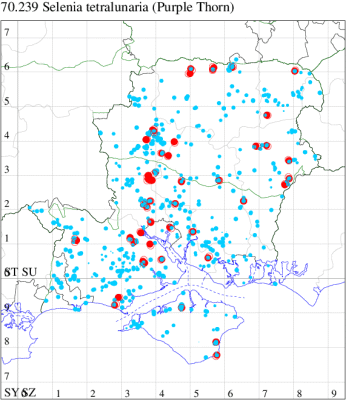
Records by year
Records by week (adult)
Records by week (larval)
Record Summary
VC10: Earliest: Parkhurst Forest, 28 Jul, 1 (IOu) Latest: Shanklin, 06 Aug, 1 (IOu) Max count: Parkhurst Forest, 28 Jul, 1 (IOu)
VC11: Earliest: Furze Hill, NF, 19 Jul, 0 (RBW, MWa) Latest: Everton, 29 Jul, 1 (MMcM) Max count: Wickham, 13 Jul, 4 (JRDS)
VC12: Earliest: Cholderton, 10 Jul, 2 (TJN, HE) Latest: Yateley, 16 Apr, 1 (JHH) Max count: Chilbolton, 14 Jul, 4 (GCE)
70.240 [B&F: 1920] Scalloped Hazel Odontopera bidentata (Clerck, 1759) - Common
Common in woodland, scrub, hedgerows, plantations, parks and gardens, throughout the British Isles. Wingspan 46-50 mm. Larva feeds on various woody plants, including Hazel, Silver and Downy Birch, Hawthorn, Blackthorn, Oak and some coniferous trees, over-wintering as a pupa.
Records prior to 2020
| Vice County | #Records | #Individuals | First Record | Last Record |
|---|---|---|---|---|
| 10 | 269 | 317 | 1943 | 2019 |
| 11 | 1622 | 2391 | 1951 | 2019 |
| 12 | 665 | 852 | 1951 | 2019 |
2020 records
| Vice County | #Records | #Individuals | Max Quantity |
|---|---|---|---|
| 10 | 16 | 16 | 2 |
| 11 | 53 | 56 | 2 |
| 12 | 25 | 26 | 2 |
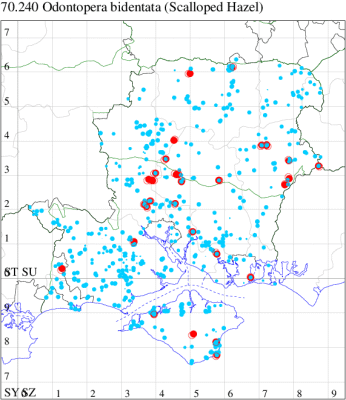
Records by year
Records by week (adult)
Records by week (larval)
Record Details
VC10: Cranmore, present, to actinic, 25 Apr (CHic); Bonchurch, one, 08 May; one, 12 May; one, 15 May; one, 16 May; one, 29 May; one, 07 Jun (JHa); Rookley, one, to actinic, 24 May (JBa); Shanklin, two, 09 May; one, 14 May; one, 18 May; one, 19 May; one, 22 May; one, 25 May; one, 30 May; one, 04 Jun (IOu);
VC11: Brockwood, two, 16 May; two, 23 May (SDut); Beaulieu Heath, NF, present, field observation, 25 Apr (iNat); Ashurst, NF, one, 22 Apr; one, 21 May (SAB); Romsey, one, 01 May; one, 19 May (SLay); one, 04 May; one, 06 May (MB); Kings Somborne, one, to actinic, 21 May (GCE); Romsey, one, 03 May; one, 04 May; one, 07 May; one, 08 May; one, 09 May; one, to actinic, 18 May; one, 19 May; two, to actinic, 21 May; one, 22 May; two, 24 May; one, to actinic, 24 May; one, to actinic, 29 May (NRJ); Kings Somborne, one, to actinic, 21 May; Hursley, one, to actinic, 21 May; Kings Somborne, one, to actinic, 26 May (GCE); Eastleigh, one, to actinic, 12 May (KArb); Allbrook, one, 21 May (SI); Winchester, one, 03 May (THW); Teg Down, one, to actinic, 24 May; one, to actinic, 20 May (EmPe); Fareham, one, ♂, 09 May (KJW); Botley, one, to actinic, 04 May (SLB); Shirrell Heath, one, 17 May; one, 18 May (LEdg); Wickham, one, 26 Apr; one, 08 May; one, 09 May; two, 16 May; one, 20 May; one, 22 May; two, 24 May; one, 28 May; one, 29 May; one, 31 May; one, 22 Jul (JRDS); Portsmouth, one, 20 May (IRT); Northney, Hayling Island, present, 16 Jun; present, 26 Jun (JWP); Sway, one, 09 May; one, 19 May (SKe);
VC12: Crawley, one, 03 May (TNo); Teg Down, Winchester, one, 17 May (CKn); Harestock, one, to actinic, 27 Apr (GRog); Barton Stacey, one, to actinic, 27 May (GCE); Ecchinswell, one, to actinic, 16 May (MTa, CSu); Cheriton, one, to actinic, 08 May; one, to actinic, 09 May (DAS); Ropley, one, 26 May (TJN, LF); Pamber Forest, one, 04 May; two, 07 May; one, 18 May (GJD); Liss, one, 16 May (LBe); Liss Forest, one, 25 May (RJM); Alton, one, to actinic, 21 May (BCA); one, to actinic, 18 May (NDP); one, to actinic, 01 May; one, to actinic, 09 May (CJP); Whitehill, one, 24 Apr; one, to actinic, 27 Apr; one, to actinic, 08 May; one, to actinic, 09 May; one, to actinic, 21 May (ASto); Hammer Vale, Woolmer, one, 21 May (ASw)
70.241 [B&F: 1921] Scalloped Oak Crocallis elinguaria (Linnaeus, 1758) - Common
Common in woodland, scrub, hedgerows, parks and gardens, throughout the British Isles. Wingspan 40-46 mm. Larva feeds on various broad-leaved trees and shrubs, including Hawthorn, Blackthorn, Downy and Silver Birch, Oak, Honeysuckle and Bilberry.
Records prior to 2020
| Vice County | #Records | #Individuals | First Record | Last Record |
|---|---|---|---|---|
| 10 | 579 | 871 | 1951 | 2019 |
| 11 | 8040 | 13722 | 1951 | 2019 |
| 12 | 1568 | 2494 | 1951 | 2019 |
2020 records
| Vice County | #Records | #Individuals | Max Quantity |
|---|---|---|---|
| 10 | 46 | 90 | 6 |
| 11 | 366 | 530 | 7 |
| 12 | 123 | 186 | 6 |
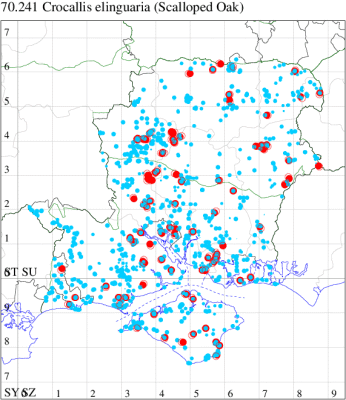
Records by year
Records by week (adult)
Records by week (larval)
Record Summary
VC10: Earliest: Freshwater Cliffs, 09 Jul, 1 (SDa) Latest: East Cowes, 08 Aug, 1 (TWhi) Max count: Rookley, 21 Jul, 6 (JBa)
VC11: Earliest: Brockwood, 30 Jul, 4 (SDut) Latest: Southsea, 01 Aug, 1 (JGe) Max count: Kings Somborne, 22 Jul, 7 (GCE)
VC12: Earliest: Cholderton, 10 Jul, 1 (TJN, HE) Latest: Yateley, 31 Jul, 1 (JHH) Max count: Axmansford, 23 Jul, 6 (ACB)
70.243 [B&F: 1922] Swallow-tailed Moth Ourapteryx sambucaria (Linnaeus, 1758) - Common
Common in woodland, scrub, hedgerows, parks and gardens, throughout the British Isles. Wingspan 50-62 mm. One of the largest and most spectacular geometers. Larva feeds on woody plants such as Blackthorn, Hawthorn, Goat Willow, Black Currant, Elder, Horse Chestnut and Ivy.
Records prior to 2020
| Vice County | #Records | #Individuals | First Record | Last Record |
|---|---|---|---|---|
| 10 | 447 | 841 | 1951 | 2019 |
| 11 | 4151 | 5838 | 1949 | 2019 |
| 12 | 1584 | 2718 | 1951 | 2019 |
2020 records
| Vice County | #Records | #Individuals | Max Quantity |
|---|---|---|---|
| 10 | 20 | 29 | 3 |
| 11 | 115 | 136 | 7 |
| 12 | 61 | 104 | 7 |
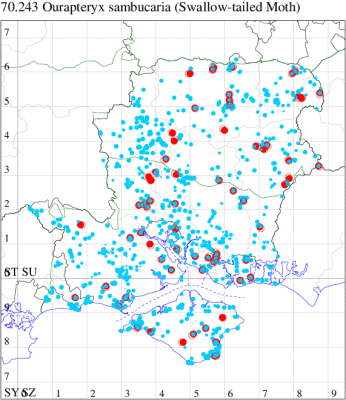
Records by year
Records by week (adult)
Records by week (larval)
Record Summary
VC10: Earliest: Freshwater Cliffs, 02 Jul, 1 (SDa) Latest: Broadley Copse, 25 Jun, 1 (JBa) Max count: Bonchurch, 25 Jun, 3 (JHa)
VC11: Earliest: Godshill, NF, 12 Jul, 0 (RBW, MWa) Latest: Southsea, 25 Jun, 2 (JGe) Max count: Milford on Sea, 25 Jun, 7 (MMcM)
VC12: Earliest: Anna Valley, Andover, 25 Jun, 7 (TJN) Latest: Yateley, 23 Jun, 4 (JHH) Max count: Anna Valley, Andover, 25 Jun, 7 (TJN)
70.244 [B&F: 1923] Feathered Thorn Colotois pennaria (Linnaeus, 1761) - Common
Common in broad-leaved woodland, areas with scattered trees, parks and gardens, throughout the British Isles, but under-recorded due to its late flight season; well distributed and common in Hampshire and on the Isle of Wight. Wingspan 46-50 mm. Unmistakable. Larva feeds on various broad-leaved trees, including Oak, Hawthorn, Blackthorn, Apple, Dog-rose, Birch, Hazel, Willow and Poplar, over-wintering as an egg.
Records prior to 2020
| Vice County | #Records | #Individuals | First Record | Last Record |
|---|---|---|---|---|
| 10 | 363 | 960 | 1978 | 2019 |
| 11 | 2101 | 3480 | 1951 | 2019 |
| 12 | 920 | 1963 | 1951 | 2019 |
2020 records
| Vice County | #Records | #Individuals | Max Quantity |
|---|---|---|---|
| 10 | 16 | 54 | 11 |
| 11 | 87 | 137 | 10 |
| 12 | 51 | 94 | 8 |
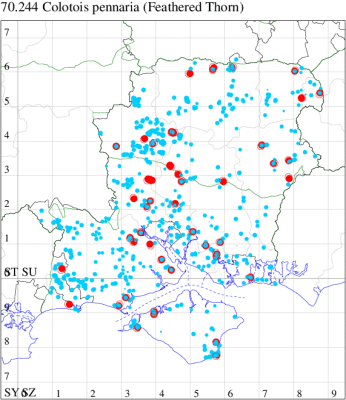
Records by year
Records by week (adult)
Records by week (larval)
Record Summary
VC10: Earliest: Freshwater Bay, 07 Nov, 1 (SDa) Latest: Shanklin, 28 Nov, 1 (IOu) Max count: Bonchurch, 07 Nov, 11 (JHa)
VC11: Earliest: Brockwood, 11 Nov, 3 (SDut) Latest: Southsea, 10 Nov, 1 (JRL) Max count: Kings Somborne, 16 Nov, 10 (GCE)
VC12: Earliest: Over Wallop, 17 Oct, 1 (CM) Latest: Yateley, 08 Nov, 3 (JHH) Max count: Crawley, 17 Nov, 8 (GCE)
70.245 [B&F: 1663] March Moth Alsophila aescularia ([Denis & Schiffermüller], 1775) - Common
Common in open woodland, parks and gardens throughout the British Isles. Widespread and common in Hampshire and on the Isle of Wight. Wingspan male 34-38 mm, female wingless. Male has a distinctive resting posture and shape, with narrow, overlapping forewings and straight costa, giving the appearance of an arrow-head, and the forewing shows a distinct dentate subterminal fascia; the flightless female is very easy to overlook, but can be distinguished from other flightless females by the brown anal tuft and complete absence of wings. Larva feeds on numerous broad-leaved trees and shrubs, including Oak, Hawthorn, Blackthorn and Crab Apple, over-wintering as a pupa.
Records prior to 2020
| Vice County | #Records | #Individuals | First Record | Last Record |
|---|---|---|---|---|
| 10 | 278 | 509 | 1981 | 2019 |
| 11 | 1204 | 1784 | 1951 | 2019 |
| 12 | 774 | 1546 | 1951 | 2019 |
2020 records
| Vice County | #Records | #Individuals | Max Quantity |
|---|---|---|---|
| 10 | 31 | 51 | 5 |
| 11 | 16 | 32 | 7 |
| 12 | 14 | 20 | 6 |
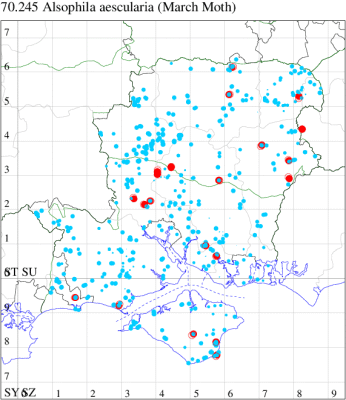
Records by year
Records by week (adult)
Records by week (larval)
Record Details
VC10: Bonchurch, one, 13 Mar; one, 15 Mar; two, 16 Mar; one, 17 Mar; two, 18 Mar; two, 23 Mar; one, 24 Mar; two, 01 Apr; two, 02 Apr; one, 03 Apr; one, 06 Apr; three, 08 Apr; two, 10 Apr; three, 11 Apr (JHa); Rookley, two, to actinic, 27 Mar; one, to actinic, 01 Apr; one, 02 Apr; one, to actinic, 12 Apr; one, field observation, 15 Apr; one, to actinic, 18 Apr (JBa); Shanklin, one, 21 Feb; two, 23 Feb; one, 15 Mar; two, 17 Mar; five, 02 Apr; two, 06 Apr; one, 08 Apr; three, 09 Apr; one, 10 Apr; one, 14 Apr; one, 16 Apr (IOu);
VC11: Stanbrige Earls, one, to actinic, ♂, 16 Apr (JRMi); Romsey, one, 16 Apr (SLay); three, 07 Feb; one, 08 Mar; four, 10 Mar; two, 11 Mar; two, 17 Mar; one, to actinic, 11 Apr (NRJ); Ashley, two, to actinic, 17 Mar; Kings Somborne, one, to actinic, 17 Mar (GCE); Botley Wood, seven, 13 Mar (F.M.G.); three, 17 Mar (KJW); Fareham, one, to actinic, 27 Mar (MLO); Burton, nr Christchurch, one, 10 Apr (JSw); Milford on Sea, one, 07 Apr (MMcM);
VC12: Crawley, two, to actinic, 18 Mar; one, to actinic, 18 Mar (GCE); Cheriton, one, to actinic, 02 Apr; one, to actinic, 09 Apr (DAS); Basingstoke, one, 08 Apr (MJW); Pamber Forest, six, 23 Feb (GJD); Liss Forest, one, 23 Feb (RJM); Alton, one, to actinic, 17 Mar; one, to actinic, 02 Apr (BCA); one, to actinic, 09 Apr (DBO); Whitehill, one, to actinic, 23 Feb; one, to actinic, 05 Apr (ASto); Farnham, one, 01 Mar (MA); Fleet, one, 14 Mar (MHals)
70.246 [B&F: 1925] Small Brindled Beauty Apocheima hispidaria ([Denis & Schiffermüller], 1775) - Local
Local in oak woodland and mature hedgerows throughout much of England and Wales, less frequently in the north. In Hampshire and on the Isle of Wight common and widespread, but with a very short flight season, the date of which is subject to the prevailing early spring weather, it may go under-recorded in some years. Wingspan male 35-37 mm, female wingless. For females, the main confusion species is Pale Brindled Beauty Phigalia pilosaria, for males, Brindled Beauty Lycia hirtaria, which see. Larva feeds on various deciduous trees, including Oak, Hawthorn, Silver Birch, Hazel, Elm, Hornbeam and Sweet Chestnut, over-wintering as a pupa.
Records prior to 2020
| Vice County | #Records | #Individuals | First Record | Last Record |
|---|---|---|---|---|
| 10 | 93 | 273 | 1964 | 2018 |
| 11 | 859 | 2092 | 1946 | 2019 |
| 12 | 273 | 491 | 1951 | 2019 |
2020 records
| Vice County | #Records | #Individuals | Max Quantity |
|---|---|---|---|
| 11 | 2 | 2 | 1 |
| 12 | 3 | 7 | 6 |
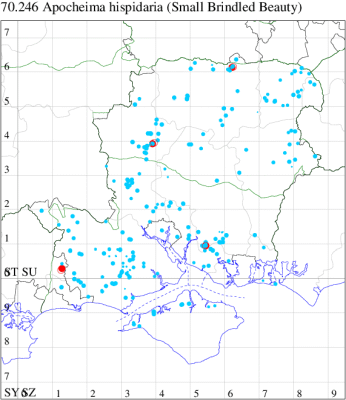
Records by year
Records by week (adult)
Records by week (larval)
Record Details
VC11: Brockwood, one, 21 Feb (SDut); Botley Wood, one, 13 Mar (F.M.G.);
VC12: Chilbolton, one, to actinic, 23 Feb (GCE); Pamber Forest, six, 23 Feb (GJD); Headley, Bordon, present, 17 Feb (iNat)
70.247 [B&F: 1926] Pale Brindled Beauty Phigalia pilosaria ([Denis & Schiffermüller], 1775) - Common
Common in broad-leaved woodland, gardens, and areas with scattered trees throughout the British Isles. Widespread and common in Hampshire and on the Isle of Wight. Wingspan male 45-50 mm, female wingless. Males somewhat similar to Brindled Beauty Lycia hirtaria, but smaller and paler, and lacking the thick, black cross-lines of Brindled Beauty. Larva feeds on various broad-leaved trees and shrubs, including Hawthorn, Blackthorn, Downy and Silver Birch, Alder, Hazel, Goat Willow, Alder Buckthorn, Buckthorn and Lime.
Records prior to 2020
| Vice County | #Records | #Individuals | First Record | Last Record |
|---|---|---|---|---|
| 10 | 163 | 360 | 1976 | 2019 |
| 11 | 1150 | 2649 | 1946 | 2019 |
| 12 | 426 | 594 | 1951 | 2019 |
2020 records
| Vice County | #Records | #Individuals | Max Quantity |
|---|---|---|---|
| 10 | 3 | 5 | 3 |
| 11 | 13 | 19 | 4 |
| 12 | 11 | 9 | 2 |
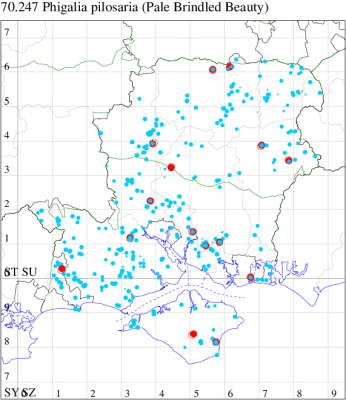
Records by year
Records by week (adult)
Records by week (larval)
Record Details
VC10: Rookley, one, field observation, 22 Feb (JBa); Shanklin, three, 23 Feb; one, 03 Mar (IOu);
VC11: Brockwood, one, 21 Feb (SDut); Copythorne, one, 02 Feb (JAda); Woodlands, New Forest, present, 30 Jan (RBW); Romsey, one, 07 Jan; one, 23 Jan; one, 25 Jan; one, 01 Feb; two, 02 Feb; three, 07 Feb (NRJ); Botley Wood, four, 24 Jan (F.M.G.); Botley, one, to actinic, 29 Jan (SLB); Wickham Common, two, 07 Feb (F.M.G.); Portsmouth, one, 07 Jan (IRT);
VC12: Chilbolton, one, to actinic, 25 Jan; two, to actinic, 02 Feb; Crawley, one, to actinic, 18 Mar (GCE); Axmansford, one, to lighted window, 30 Jan (ACB); Pamber Forest, one, field observation, 26 Jan (GJD); Alton, one, to actinic, 22 Jan; one, to lighted window, 17 Feb (BCA); Whitehill, one, to artificial light, 28 Nov (ASto); Headley, Bordon, present, 17 Jan; present, 01 Feb; present, 01 Feb (iNat)
70.248 [B&F: 1927] Brindled Beauty Lycia hirtaria (Clerck, 1759) - Common
Common in broad-leaved woodland, scrub, hedgerows, parks and gardens throughout England, Wales and southern Scotland, a species of conservation concern under the UK Biodiversity Action Plan. In Hampshire and on the Isle of Wight widespread, but only found in numbers in mature oak woodland, and much less numerously than in the past. Wingspan 42-52 mm. The male is most likely to be confused with Pale Brindled Beauty Phigalia pilosaria, from which readily distinguished by the prominent black cross-lines of Brindled Beauty. Larva feeds on various broad-leaved trees and shrubs, including Birch, Hawthorn, Alder, Sallow, Oak, Elm and Lime, over-wintering as a pupa.
Records prior to 2020
| Vice County | #Records | #Individuals | First Record | Last Record |
|---|---|---|---|---|
| 10 | 31 | 22 | 1930 | 2019 |
| 11 | 1089 | 1783 | 1948 | 2019 |
| 12 | 608 | 1438 | 1949 | 2019 |
2020 records
| Vice County | #Records | #Individuals | Max Quantity |
|---|---|---|---|
| 10 | 6 | 7 | 2 |
| 11 | 174 | 301 | 10 |
| 12 | 78 | 145 | 11 |
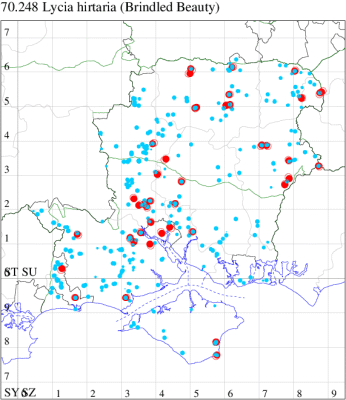
Records by year
Records by week (adult)
Records by week (larval)
Record Summary
VC10: Earliest: Bonchurch, 10 Apr, 2 (JHa) Latest: Shanklin, 12 Apr, 1 (IOu) Max count: Bonchurch, 10 Apr, 2 (JHa)
VC11: Earliest: Brockwood, 15 Apr, 2 (SDut) Latest: Boldre, 22 Apr, 3 (JDur) Max count: Copythorne, 12 Apr, 10 (JAda)
VC12: Earliest: Chilbolton, 04 Apr, 1 (GCE) Latest: Yateley, 09 May, 1 (JHH) Max count: Liss Forest, 17 Apr, 11 (RJM)
70.251 [B&F: 1930] Oak Beauty Biston strataria (Hufnagel, 1767) - Common
Common in oak woodland, gardens, and areas with scattered trees throughout England and southern Scotland. Widespread and common in Hampshire and on the Isle of Wight. Wingspan 51-56 mm. Larva feeds on various broad-leaved trees and shrubs, including Oak, Hazel, Aspen, Alder and Elm.
Records prior to 2020
| Vice County | #Records | #Individuals | First Record | Last Record |
|---|---|---|---|---|
| 10 | 231 | 410 | 1856 | 2019 |
| 11 | 2871 | 5470 | 1951 | 2019 |
| 12 | 843 | 1768 | 1951 | 2019 |
2020 records
| Vice County | #Records | #Individuals | Max Quantity |
|---|---|---|---|
| 10 | 21 | 27 | 3 |
| 11 | 81 | 151 | 10 |
| 12 | 23 | 31 | 3 |
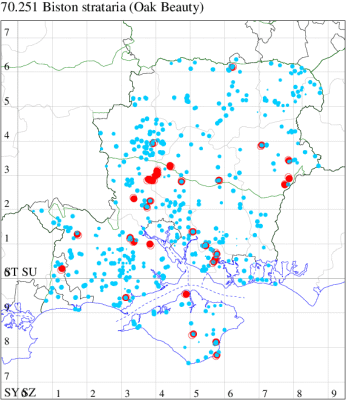
Records by year
Records by week (adult)
Records by week (larval)
Record Summary
VC10: Earliest: Cowes, 08 Mar, 1 (DNor) Latest: Shanklin, 31 Mar, 1 (IOu) Max count: Bonchurch, 01 Apr, 3 (JHa)
VC11: Earliest: Brockwood, 26 Mar, 1 (SDut) Latest: Boldre, 04 Apr, 1 (JDur) Max count: Hursley, 14 Mar, 10 (GCE)
VC12: Earliest: Chilbolton, 25 Jan, 1 (GCE) Latest: Whitehill, 16 Mar, 2 (ASto) Max count: Chilbolton, 17 Mar, 3 (GCE)
70.252 [B&F: 1931] Peppered Moth Biston betularia (Linnaeus, 1758) - Common
Common in woodland, scrub, hedgerows, parks and gardens throughout the British Isles. Widespread and common in Hampshire and on the Isle of Wight. Wingspan 45-62 mm. In the past, dark forms predominated in urban areas. Larva feeds on many different types of tree and shrub, including Blackthorn, Hawthorn, Birch and Lime, and some herbaceous plants, including Mugwort and Goldenrod, over-wintering as a pupa.
Records prior to 2020
| Vice County | #Records | #Individuals | First Record | Last Record |
|---|---|---|---|---|
| 10 | 934 | 2101 | 1900 | 2019 |
| 11 | 8846 | 14532 | 1951 | 2019 |
| 12 | 2777 | 5986 | 1948 | 2019 |
2020 records
| Vice County | #Records | #Individuals | Max Quantity |
|---|---|---|---|
| 10 | 81 | 156 | 12 |
| 11 | 440 | 710 | 15 |
| 12 | 121 | 186 | 7 |
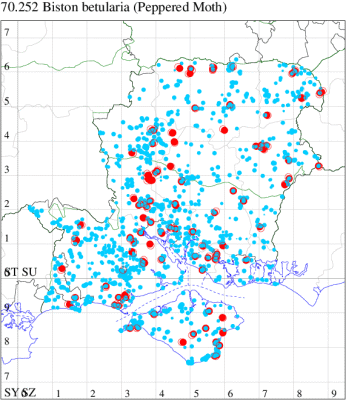
Records by year
Records by week (adult)
Records by week (larval)
Record Summary
VC10: Earliest: West High Down Quarry, 07 Aug, 3 (IOu) Latest: Firestone Copse, 21 Jul, 5 (IOu) Max count: Shanklin, 24 Jun, 12 (IOu)
VC11: Earliest: Brockwood, 16 May, 1 (SDut) Latest: Pilley Bailey, NF, 07 Jul, 1 (RBW, MWa) Max count: Romsey, 03 Jul, 15 (NRJ)
VC12: Earliest: Cholderton, 10 Jul, 1 (TJN, HE) Latest: Yateley, 08 Aug, 2 (JHH) Max count: Liss Forest, 04 Jul, 7 (RJM)
70.253 [B&F: 1932] Spring Usher Agriopis leucophaearia ([Denis & Schiffermüller], 1775) - Common
Common in deciduous, especially oak, woodland, mature hedgerows, parks and gardens throughout the British Isles. Widespread and reasonably common in Hampshire and on the Isle of Wight. Wingspan male 31-37 mm, female wingless. Much more delicate than the superficially similar Mottled Umber Erannis defoliaria. Larva feeds on Pedunculate and Sessile Oak, over-wintering as a pupa.
Records prior to 2020
| Vice County | #Records | #Individuals | First Record | Last Record |
|---|---|---|---|---|
| 10 | 113 | 699 | 1903 | 2019 |
| 11 | 873 | 1884 | 1946 | 2019 |
| 12 | 233 | 412 | 1951 | 2019 |
2020 records
| Vice County | #Records | #Individuals | Max Quantity |
|---|---|---|---|
| 10 | 1 | 0 | 0 |
| 11 | 18 | 71 | 16 |
| 12 | 6 | 10 | 2 |
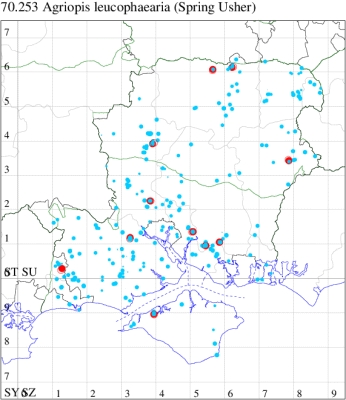
Records by year
Records by week (adult)
Records by week (larval)
Record Details
VC10: Cranmore, present, to actinic, 03 Feb (CHic);
VC11: Brockwood, one, 31 Jan (SDut); Woodlands, New Forest, present, 01 Feb (RBW); Romsey, six, 07 Jan; one, 08 Jan; one, 12 Jan; 15, 23 Jan; 16, 25 Jan; two, 30 Jan; 10, 01 Feb; three, 02 Feb; two, 07 Feb (NRJ); Botley Wood, seven, 24 Jan (F.M.G.); Botley, one, to actinic, 24 Jan; one, to actinic, 24 Jan; one, to actinic, 26 Jan; one, to actinic, 26 Jan; one, to actinic, 12 Feb (SLB); Wickham Common, two, 07 Feb (F.M.G.);
VC12: Chilbolton, two, to actinic, 25 Jan; two, to actinic, 30 Jan; two, to actinic, 02 Feb (GCE); Axmansford, two, to lighted window, 17 Feb (ACB); Pamber Forest, one, 23 Feb (GJD); Whitehill, one, to actinic, 31 Jan (ASto)
70.254 [B&F: 1933] Scarce Umber Agriopis aurantiaria (Hübner, [1799]) - Common
Common despite its name, in broad-leaved woodland, scrub and gardens throughout the British Isles. In Hampshire and on the Isle of Wight widespread and fairly common, although no doubt under-recorded due to its late season. Wingspan male 40-44 mm, female wingless. The main confusion species is Mottled Umber Erannis defoliaria, from which male Scarce Umber is perhaps most reliably separated by its rounded termen and more open apical angle, but in most cases the uniformly orange-yellow forewing of Scarce Umber distinguishes from the very much more variable Mottled Umber; female Scarce Umber has short wing stumps, absent in Mottled Umber. Larva feeds on numerous broad-leaved trees and shrubs, over-wintering as an egg.
Records prior to 2020
| Vice County | #Records | #Individuals | First Record | Last Record |
|---|---|---|---|---|
| 10 | 97 | 358 | 1924 | 2019 |
| 11 | 300 | 335 | 1951 | 2019 |
| 12 | 147 | 177 | 1951 | 2019 |
2020 records
| Vice County | #Records | #Individuals | Max Quantity |
|---|---|---|---|
| 10 | 3 | 4 | 3 |
| 11 | 1 | 1 | 1 |
| 12 | 3 | 3 | 1 |
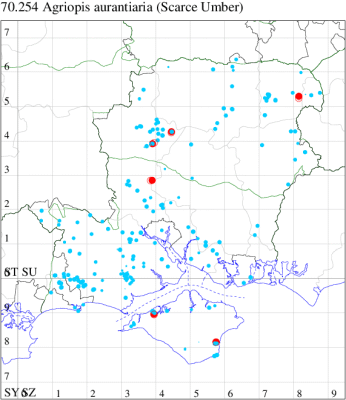
Records by year
Records by week (adult)
Records by week (larval)
Record Details
VC10: Cranmore, present, to actinic, 23 Nov (CHic); Shanklin, one, 08 Nov; three, 10 Nov (IOu);
VC11: Kings Somborne, one, to actinic, 16 Nov (GCE);
VC12: Chilbolton, one, to actinic, 23 Nov (SLE det. GCE); Barton Stacey, one, to actinic, 22 Oct (GCE); Fleet, one, 02 Nov (MHals)
70.255 [B&F: 1934] Dotted Border Agriopis marginaria (Fabricius, [1777]) - Common
Common in woodland, scrub, hedgerows, gardens, heathland and moorland throughout the British Isles. Widespread and common in Hampshire and on the Isle of Wight. Wingspan male 36-42 mm, female flightless; principal confusion species are Mottled Umber Erannis defoliaria, which lacks row of dark spots on termen, and Scarce Umber A. aurantiaria, which differs in wing shape and is always golden yellow; Dotted Border ab. fuscata is plain brown. Larva feeds on various broad-leaved trees and shrubs, including Pedunculate and Sessile Oak, Hawthorn, Blackthorn, Downy and Silver Birch, Hazel, Willow, Elm, Sycamore, Apple, Plum and Heather, over-wintering as a pupa.
Records prior to 2020
| Vice County | #Records | #Individuals | First Record | Last Record |
|---|---|---|---|---|
| 10 | 282 | 464 | 1981 | 2019 |
| 11 | 1355 | 1791 | 1951 | 2019 |
| 12 | 545 | 764 | 1951 | 2019 |
2020 records
| Vice County | #Records | #Individuals | Max Quantity |
|---|---|---|---|
| 10 | 15 | 21 | 3 |
| 11 | 10 | 11 | 2 |
| 12 | 11 | 8 | 2 |
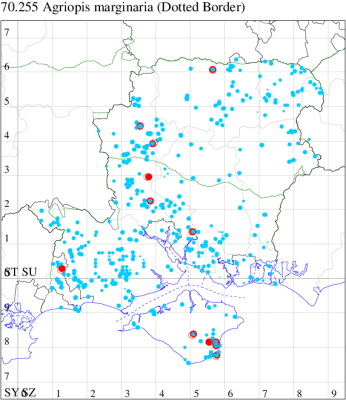
Records by year
Records by week (adult)
Records by week (larval)
Record Details
VC10: Bonchurch, two, 03 Apr (JHa); Rookley, one, 02 Apr (JBa); Shanklin, one, at dusk, 24 Feb; one, at dusk, 18 Feb; two, 24 Jan; two, 21 Feb; Sibden Hill, two, at dusk, 23 Feb; Shanklin, one, 11 Mar; three, 14 Mar; one, 17 Mar; one, 25 Mar; one, 01 Apr; one, 05 Apr; one, 08 Apr; one, 09 Apr (IOu);
VC11: Brockwood, one, 21 Feb (SDut); Copythorne, one, 02 Feb (JAda); Kings Somborne, one, to actinic, 19 Feb (GCE); Romsey, one, 02 Feb; one, 07 Apr; two, 08 Apr (NRJ); Botley, one, to actinic, 12 Feb; one, to actinic, 12 Feb; one, to actinic, 25 Feb; one, to actinic, 01 Mar (SLB);
VC12: Chilbolton, two, to actinic, 02 Feb (GCE); Andover, two, 25 Feb (GSD); Axmansford, one, to lighted window, 04 Feb; two, to lighted window, 17 Feb (ACB); Headley, Bordon, present, 01 Feb; present, 01 Feb; present, 07 Feb; present, 17 Feb; present, 01 Mar; present, 16 Mar (iNat)
70.256 [B&F: 1935] Mottled Umber Erannis defoliaria (Clerck, 1759) - Common
Common in woodland, scrub, hedgerows, grassland, heathland, moorland and gardens throughout the British Isles, at low altitudes in the north. Widespread and common in Hampshire and on the Isle of Wight. Wingspan male 40-45 mm, female wingless. Somewhat similar to Scarce Umber Agriopis aurantiaria and Dotted Border A. marginaria, which see for differences. Larva, formerly considered a pest, feeds on various broad-leaved trees and shrubs, including Oak, Birch, Hazel, Hawthorn, Blackthorn, Apple, Dog-rose, Sycamore, Hornbeam and Elm, over-wintering as an egg.
Records prior to 2020
| Vice County | #Records | #Individuals | First Record | Last Record |
|---|---|---|---|---|
| 10 | 335 | 1130 | 1977 | 2019 |
| 11 | 1437 | 3788 | 1951 | 2019 |
| 12 | 548 | 1167 | 1951 | 2019 |
2020 records
| Vice County | #Records | #Individuals | Max Quantity |
|---|---|---|---|
| 10 | 13 | 16 | 3 |
| 11 | 33 | 41 | 5 |
| 12 | 35 | 54 | 9 |
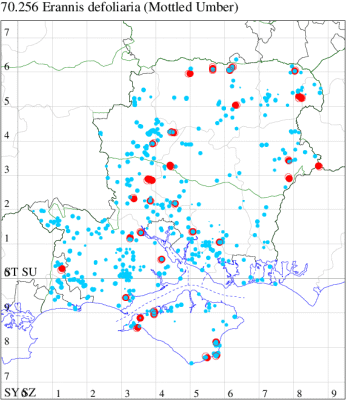
Records by year
Records by week (adult)
Records by week (larval)
Record Details
VC10: Freshwater Bay, one, 07 Nov (SDa); Western Yar Estuary, one, at dusk, 01 Jan (IOu); Cranmore, present, to actinic, 05 Jan (CHic); one, field observation, 10 Nov (KNow); Ventnor, one, field observation, 10 Dec (SRP); Bonchurch, one, 19 Jan; one, 03 Feb (JHa); Shanklin, one, 28 Sep; two, 07 Nov; one, at dusk, 07 Nov; three, 10 Nov; two, 17 Nov; one, 24 Nov (IOu);
VC11: Brockwood, three, 16 Nov (SDut); Woodlands, New Forest, present, 29 Oct (RBW); Totton, one, 11 Dec (LH); Stanbrige Earls, one, to actinic, 23 Nov; one, to actinic, 10 Dec (JRMi); Kings Somborne, one, to actinic, 16 Nov; two, to actinic, 16 Nov (GCE); Romsey, five, 07 Jan; one, 12 Jan; three, 15 Nov (NRJ); Kings Somborne, two, to actinic, 16 Nov; one, to actinic, 16 Nov (GCE); Dibden Purlieu, one, 08 Nov (RAC); Eastleigh, one, to actinic, 18 May; one, to actinic, 21 Nov (KArb); Allbrook, one, to actinic, 29 Sep; one, to actinic, 07 Nov; one, to actinic, 11 Nov; one, to actinic, 21 Nov (SI); Botley, one, to actinic, 09 Jan; one, to actinic, 09 Jan; one, to actinic, 16 Jan; one, to actinic, 16 Jan; one, to actinic, 20 Dec; one, to actinic, 22 Dec; one, to actinic, 15 Nov (SLB); Wickham Common, one, 07 Feb (F.M.G.); Lovedean, one, 07 Nov (ARJ); Northney, Hayling Island, present, 25 May (JWP); Stroud, Petersfield, one, to actinic, 16 Nov (RAll); Pennington, one, 09 Nov (RFC);
VC12: Chilbolton, one, to actinic, 29 Oct (GCE); three, to actinic, 23 Nov; five, to actinic, 11 Dec (SLE); Crawley, one, to actinic, 17 Nov; one, to actinic, 17 Nov; three, to actinic, 17 Nov; Barton Stacey, one, to actinic, 22 Oct; one, to actinic, 22 Oct; one, to actinic, 22 Oct (GCE); Ecchinswell, two, to actinic, 08 Nov (MTa, CSu); Axmansford, one, to lighted window, 01 Jan; two, to lighted window, 23 Jan; one, 21 Oct; four, 30 Oct; three, 17 Nov; Smithley's Copse, Axmansford, one, field observation, ♀, 13 Dec (ACB); Basingstoke, one, field observation, 14 Dec (DKel); Pamber Forest, one, 14 Sep; three, 08 Nov; nine, 11 Dec (GJD); Warren Hill, Liss Forest, one, 29 Nov (RJM); Whitehill, one, 12 Oct; one, to actinic, 22 Dec (ASto); Headley, Bordon, present, 06 Jan; present, 06 Jan; present, 17 Jan; present, field observation, 01 Oct; present, field observation, 21 Nov; present, field observation, 17 Dec (iNat); Hammer Vale, Woolmer, one, 16 Oct (ASw); Fleet, one, 14 Nov (MHals); Church Crookham, one, to actinic, 17 Nov; one, to actinic, 18 Nov; one, to actinic, 22 Nov (DDim); Yateley, one, to outside light, 11 Dec (JHH)
70.257 [B&F: 1936] Waved Umber Menophra abruptaria (Thunberg, 1792) - Common
Common in broad-leaved woodland, scrub, hedgerows, parks and gardens throughout England, less commonly in the north. Widespread and common in Hampshire and on the Isle of Wight. Wingspan 36-42 mm. Larva feeds on Privet and Ash, over-wintering as a pupa.
Records prior to 2020
| Vice County | #Records | #Individuals | First Record | Last Record |
|---|---|---|---|---|
| 10 | 202 | 218 | 1943 | 2019 |
| 11 | 1633 | 1762 | 1950 | 2019 |
| 12 | 585 | 663 | 1951 | 2019 |
2020 records
| Vice County | #Records | #Individuals | Max Quantity |
|---|---|---|---|
| 10 | 26 | 34 | 3 |
| 11 | 99 | 109 | 4 |
| 12 | 38 | 39 | 2 |
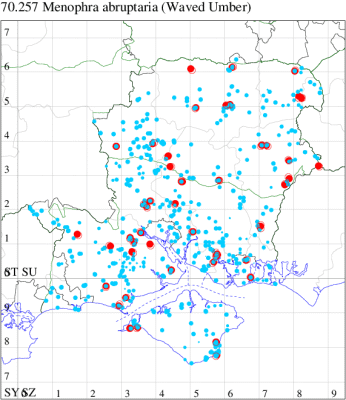
Records by year
Records by week (adult)
Records by week (larval)
Record Summary
VC10: Earliest: West High Down Quarry, 07 Aug, 1 (IOu) Latest: Shanklin, 09 Aug, 1 (IOu) Max count: Shanklin, 27 Apr, 3 (IOu)
VC11: Earliest: Frogham, 08 Apr, 1 (DBr) Latest: Pennington, 10 Apr, 2 (RFC) Max count: Sway, 11 Apr, 4 (SKe)
VC12: Earliest: Over Wallop, 23 Apr, 1 (CM) Latest: Yateley, 09 May, 1 (JHH) Max count: Cheriton, 16 Apr, 2 (DAS)
70.258 [B&F: 1937] Willow Beauty Peribatodes rhomboidaria ([Denis & Schiffermüller], 1775) - Common
Common in woodland, scrub, hedgerows, parks and gardens throughout England, Wales and southern Scotland. Widespread and common in Hampshire and on the Isle of Wight. Wingspan 40-48 mm. One of a number of confusingly similar species, including Feathered Beauty P. secundaria, Mottled Beauty Alcis repandata, Great Oak Beauty Hypomecis roboraria and Satin Beauty Deileptenia ribeata, which can be separated with care by their forewing markings. Larva feeds on Hawthorn, Plum, Privet, Silver and Downy Birch, Alder Buckthorn, Honeysuckle, Traveller's-joy and Ivy.
Records prior to 2020
| Vice County | #Records | #Individuals | First Record | Last Record |
|---|---|---|---|---|
| 10 | 2222 | 5936 | 1951 | 2019 |
| 11 | 27109 | 76300 | 200 | 2019 |
| 12 | 5381 | 13578 | 1951 | 2019 |
2020 records
| Vice County | #Records | #Individuals | Max Quantity |
|---|---|---|---|
| 10 | 206 | 716 | 24 |
| 11 | 1511 | 3944 | 21 |
| 12 | 544 | 1306 | 26 |
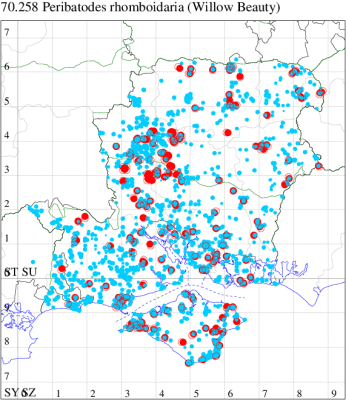
Records by year
Records by week (adult)
Records by week (larval)
Record Summary
VC10: Earliest: West High Down Quarry, 07 Aug, 8 (IOu) Latest: Seaview, 18 Jul, 1 (JMas) Max count: Haseley Manor, 09 Jun, 24 (IOu)
VC11: Earliest: Brockwood, 26 Apr, 1 (SDut) Latest: Southsea, 02 Jun, 0 (JRL) Max count: Totton, 21 May, 21 (LH)
VC12: Earliest: Over Wallop, 21 May, 1 (CM) Latest: Yateley, 16 Aug, 1 (GHa) Max count: Alton, 15 Aug, 26 (DBO)
70.262 [B&F: 1938] Bordered Grey Selidosema brunnearia (Villers, 1789) - Ireland only
Nationally scarce, on heathland, moorland and sand-dunes in southern England (Hampshire and adjoining counties), with isolated populations in north-western England and western Scotland. Also occurs in Ireland (ssp. tyronensis). In Hampshire locally common on the heaths of the New Forest, and also on sand-dunes in south Hayling, with occasional wanderers elsewhere in the county and on the Isle of Wight. Wingspan 37-43 mm. Larva feeds on Heather and Common Bird's-foot Trefoil.
Records prior to 2020
| Vice County | #Records | #Individuals | First Record | Last Record |
|---|---|---|---|---|
| 10 | 5 | 2 | 1909 | 2001 |
| 11 | 254 | 222 | 1800 | 2015 |
| 12 | 8 | 5 | 1900 | 2005 |
2020 records
| Vice County | #Records | #Individuals | Max Quantity |
|---|---|---|---|
| 11 | 26 | 49 | 11 |
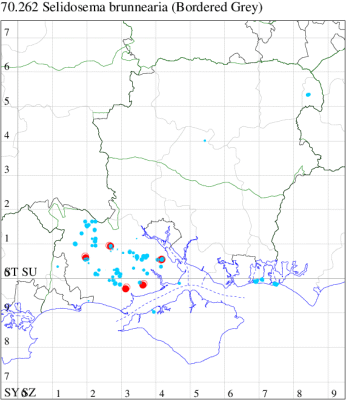
Records by year
Records by week (adult)
Records by week (larval)
Record Details
VC11: Picket Plain, NF, one, 02 Aug; one, 02 Aug (PAB); Acres Down, 11, 08 Aug (CWlk); Acres Down, NF, one, field observation, 12 Aug (REam); Applemore, one, field observation, 03 Aug (KNug); Dibden Purlieu, one, to actinic, 05 Aug; two, to actinic, 07 Aug; four, to actinic, 09 Aug; one, to actinic, 10 Aug; three, to actinic, 11 Aug; one, to actinic, 12 Aug; one, to actinic, 14 Aug; one, to actinic, 09 Aug; one, to actinic, 11 Aug; two, to actinic, 12 Aug (RAC); Lymington, one, to light, 09 Aug (ASH); Norleywood, NF, present, 09 Aug (RBW, MWa)
70.264 [B&F: 1940] Satin Beauty Deileptenia ribeata (Clerck, 1759) - Common
Common in coniferous woodland and plantations throughout much of the British Isles. In Hampshire and on the Isle of Wight widespread in woodland, but usually very uncommon. Wingspan 42-48 mm. The most likely confusion species is Mottled Beauty Alcis repandata. Larva feeds on Scots Pine, Yew, Norway Spruce, European Larch and Douglas Fir.
Records prior to 2020
| Vice County | #Records | #Individuals | First Record | Last Record |
|---|---|---|---|---|
| 10 | 39 | 70 | 1972 | 2019 |
| 11 | 222 | 377 | 1951 | 2019 |
| 12 | 99 | 122 | 1951 | 2019 |
2020 records
| Vice County | #Records | #Individuals | Max Quantity |
|---|---|---|---|
| 10 | 1 | 7 | 7 |
| 11 | 11 | 14 | 2 |
| 12 | 15 | 22 | 5 |
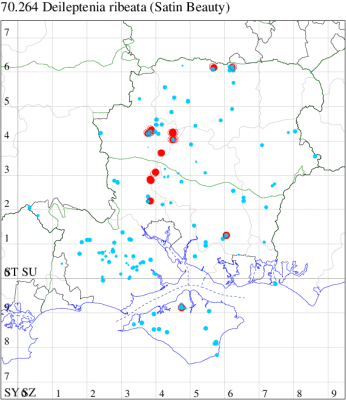
Records by year
Records by week (adult)
Records by week (larval)
Record Details
VC10: Parkhurst Forest, seven, 29 Jun (IOu);
VC11: Romsey, two, 24 Jun; one, 16 Jul (NRJ); Kings Somborne, one, to actinic, 09 Jul; two, to actinic, 09 Jul; one, to actinic, 09 Jul; one, to actinic, 15 Jul; one, to actinic, 15 Jun (GCE); Wickham, one, 27 Jun; two, 29 Jun; one, 14 Jul (JRDS); West Walk, one, 14 Aug (F.M.G. det. KJW);
VC12: Goodworth Clatford, one, to actinic, 24 Jun; Harewood Forest, one, to actinic, 24 Jun; one, to actinic, 24 Jun; one, to actinic, 23 Jul; Chilbolton, one, to actinic, 16 Jun; Barton Stacey, one, to actinic, 25 Jun; five, to actinic, 12 Jul; two, to actinic, 16 Jul; one, to actinic, 16 Jul; one, to actinic, 12 Jul; one, to actinic, 25 Jun; three, to actinic, 16 Jul (GCE); Axmansford, one, 13 Jul (ACB); Ropley*, one, 14 Jun (TJN, LF); Pamber Forest, one, 23 Jun (GJD)
70.265 [B&F: 1941] Mottled Beauty Alcis repandata (Linnaeus, 1758) - Unconfirmed
Common in woodland and hedgerows, moorland and heathland, calcareous grassland, parks and gardens throughout the British Isles. Widespread and common in Hampshire and on the Isle of Wight. Wingspan 43-56 mm. The main confusion species is Willow Beauty Peribatodes rhomboidaria, which differs principally in the two cross-line, converging at the dorsum in Willow Beauty, but not in Mottled Beauty. Larva polyphagous on a great many woody plants, including Oak, Birch, Ash, Hawthorn, Honeysuckle and Juniper.
Records prior to 2020
| Vice County | #Records | #Individuals | First Record | Last Record |
|---|---|---|---|---|
| 10 | 907 | 3488 | 1981 | 2019 |
| 11 | 4022 | 6829 | 1951 | 2019 |
| 12 | 1563 | 3429 | 1951 | 2019 |
2020 records
| Vice County | #Records | #Individuals | Max Quantity |
|---|---|---|---|
| 10 | 38 | 171 | 40 |
| 11 | 221 | 447 | 12 |
| 12 | 130 | 296 | 15 |
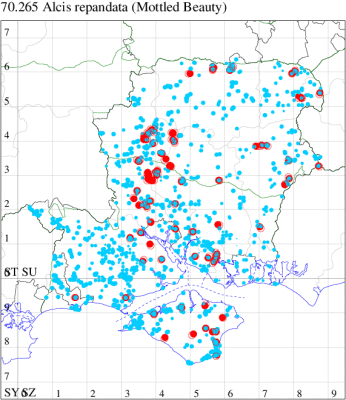
Records by year
Records by week (adult)
Records by week (larval)
Record Summary
VC10: Earliest: Cranmore, 10 Jun, 0 (CHic) Latest: Wootton Bridge, 29 Jun, 1 (KNow) Max count: Borthwood Copse, Winford, 23 Jun, 40 (IOu)
VC11: Earliest: Pig Bush, NF, 17 Jul, 1 (CL) Latest: Pennington, 14 Aug, 3 (RFC) Max count: Allbrook, 25 Jun, 12 (SI)
VC12: Earliest: Cholderton, 17 Jul, 1 (TJN, HE) Latest: Yateley, 23 Jun, 5 (JHH) Max count: Pamber Forest, 17 Jun, 15 (GJD)
70.267 [B&F: 1943] Great Oak Beauty Hypomecis roboraria ([Denis & Schiffermüller], 1775) - Nb
Nationally scarce (Nb) in ancient woodland and mature oak woodland throughout much of southern England. In Hampshire and on the Isle of Wight a species of ancient woodlands, occurring in the New Forest and other large woods, but has declined in many places through habitat destruction. Wingspan 60-68 mm. The main confusion species is Pale Oak Beauty H. punctinalis, which differs in plain apex of underwing of forewing. Larva feeds on Pedunculate Oak.
Records prior to 2020
| Vice County | #Records | #Individuals | First Record | Last Record |
|---|---|---|---|---|
| 10 | 35 | 51 | 1856 | 2019 |
| 11 | 1040 | 2150 | 1800 | 2019 |
| 12 | 292 | 656 | 1800 | 2019 |
2020 records
| Vice County | #Records | #Individuals | Max Quantity |
|---|---|---|---|
| 11 | 36 | 55 | 4 |
| 12 | 26 | 96 | 20 |
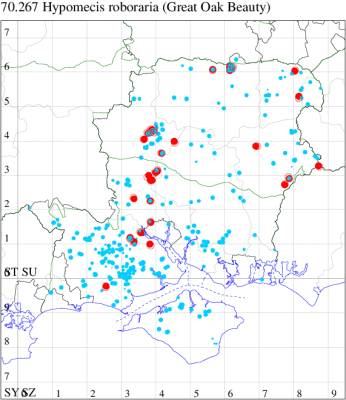
Records by year
Records by week (adult)
Records by week (larval)
Record Details
VC11: Marchwood, one, 30 May; one, 01 Jun (CTh); Woodlands, New Forest, present, 13 Jun (RBW); Ashurst, NF, one, 07 Jun (SAB); Totton, one, 22 May (LH); Rownhams, two, 27 May; one, 22 Jun (AMS); Stanbrige Earls, one, to actinic, 19 Jun (JRMi); Ashley, one, to actinic, 23 Jun (GCE); Romsey, one, 30 May; two, 02 Jun (NRJ); Kings Somborne, one, to actinic, 11 Jun; one, to actinic, 09 Jul; one, to actinic, 11 Jun; four, to actinic, 11 Jun; two, to actinic, 15 Jun; two, to actinic, 15 Jun; one, to actinic, 15 Jun (GCE); Wickham, one, 01 Jun; two, 08 Jun; one, 12 Jun; three, 13 Jun; two, 14 Jun; three, 15 Jun; one, 16 Jun; three, 17 Jun; three, 19 Jun; three, 23 Jun; one, 24 Jun (JRDS); Lovedean, one, 25 Jun (ARJ); Petersfield, one, to actinic, 18 Jul (RAll); Sway, one, 08 Jun (S&SL);
VC12: Wherwell, one, to actinic, 29 Jun; Goodworth Clatford, two, to actinic, 24 Jun; Harewood Forest, one, to actinic, 23 May; five, to actinic, 24 Jun; one, to actinic, 24 Jun; five, to actinic, 24 Jun; seven, to actinic, 24 Jun; five, to actinic, 24 Jun; 16, to actinic, 24 Jun; five, to actinic, 24 Jun; Chilbolton, one, to actinic, 16 Jun; Barton Stacey, one, to actinic, 27 May (GCE); Axmansford, one, 02 Jun (ACB); Beech, one, 15 Jun (NDP); Pamber Forest, 11, 14 Jun; 20, 25 Jun; three, 15 Jun; one, 17 Jun (GJD); Liss, one, 25 Jun; two, 14 Sep (LBe); Liss Forest, one, 20 Jun (RJM); Hammer Vale, Woolmer, one, 08 Jun; one, 25 Jun (ASw); Fleet, one, 01 Jun (MHals); Yateley*, one, 16 Jun (JHH)
70.268 [B&F: 1944] Pale Oak Beauty Hypomecis punctinalis (Scopoli, 1763) - Common
Common in broad-leaved woodland, scrub, parks and gardens throughout much of southern England. In Hampshire and on the Isle of Wight still fairly common in deciduous woodland, but its range shows signs of contracting, especially in the New Forest. Wingspan 46-55 mm. The main confusion species is Great Oak Beauty H. roboraria, which differs in dark border to apex of underwing of forewing. Larva feeds on Oak, Birch, Hazel, Hawthorn, Apple and Sallow, over-wintering as a pupa.
Records prior to 2020
| Vice County | #Records | #Individuals | First Record | Last Record |
|---|---|---|---|---|
| 10 | 116 | 134 | 1856 | 2019 |
| 11 | 874 | 999 | 1951 | 2019 |
| 12 | 455 | 773 | 1951 | 2019 |
2020 records
| Vice County | #Records | #Individuals | Max Quantity |
|---|---|---|---|
| 10 | 2 | 2 | 1 |
| 11 | 33 | 37 | 2 |
| 12 | 26 | 38 | 10 |
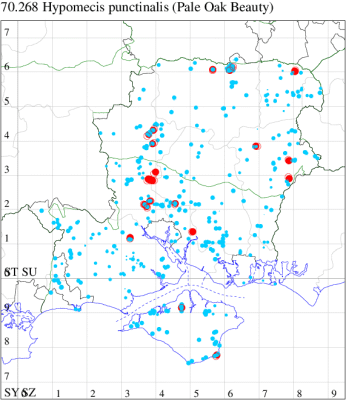
Records by year
Records by week (adult)
Records by week (larval)
Record Details
VC10: Parkhurst Forest, one, 29 Jun (IOu); Bonchurch, one, 22 Jun (JHa);
VC11: Woodlands, New Forest, present, 29 May (RBW); Romsey, one, 26 May (SLay); one, 20 May (MB); Kings Somborne, one, to actinic, 21 May; one, to actinic, 11 Jun (GCE); Romsey, one, 09 May; one, 15 May; two, to actinic, 26 May; one, 28 May; one, to actinic, 29 May; one, to actinic, 30 May; two, 02 Jun; one, 08 Jun (NRJ); Kings Somborne, one, to actinic, 11 Jun; two, to actinic, 11 Jun; one, to actinic, 21 May; two, to actinic, 11 Jun; one, to actinic, 11 Jun; Hursley, one, to actinic, 11 Jun; Kings Somborne, two, to actinic, 26 May (GCE); Eastleigh, one, to actinic, 18 May; one, to actinic, 26 May (KArb); Allbrook, one, 01 Jun (SI); Botley, one, to actinic, 11 Jun (SLB); Wickham, one, 25 May; one, 27 May; one, 31 May (JRDS);
VC12: Chilbolton, one, to actinic, 03 Jun; Goodworth Clatford, one, to actinic, 23 May; Harewood Forest, one, to actinic, 23 May (GCE); Axmansford, one, 02 Jun (ACB); Beech, one, 07 Jun; one, 13 Jun; one, 23 Jun (NDP); Pamber Forest, two, 28 May; 10, 30 May; two, 14 Jun; one, 04 Jun; one, 08 Jun; one, 15 Jun; one, 17 Jun; two, 23 Jun (GJD); Liss Forest, one, 21 May; one, f. humperti, 21 May; one, f. humperti, 25 May; one, 25 May; one, 20 Jun; one, 01 Aug (RJM); Whitehill, one, to actinic, 29 May (ASto); Yateley*, one, 08 Jun; one, 21 May; one, 26 May (JHH)
70.270 [B&F: 1947] Engrailed Ectropis crepuscularia ([Denis & Schiffermüller], 1775) - Local
Common in broad-leaved woodland, hedgerows, parks and gardens throughout the British Isles. Widespread and common in Hampshire and on the Isle of Wight. Wingspan 38-45 mm. Considered traditionally to be one of a species pair separated on flight period, no consistent genitalic or genetic differences have been found and certainly on the continent, 'Engrailed' is considered to be one species, which is followed here. Larva feeds on the foliage of many different woody plants, including Sessile and Pedunculate Oak, Downy and Silver Birch, Hazel, Hawthorn, Sallow, Broom, Buckthorn, Spindle, Wild Privet and Hornbeam, over-wintering as a pupa.
Records prior to 2020
| Vice County | #Records | #Individuals | First Record | Last Record |
|---|---|---|---|---|
| 10 | 681 | 1137 | 1856 | 2019 |
| 11 | 2821 | 3991 | 1951 | 2019 |
| 12 | 1179 | 1926 | 1951 | 2019 |
2020 records
| Vice County | #Records | #Individuals | Max Quantity |
|---|---|---|---|
| 10 | 37 | 76 | 6 |
| 11 | 38 | 41 | 2 |
| 12 | 49 | 53 | 2 |
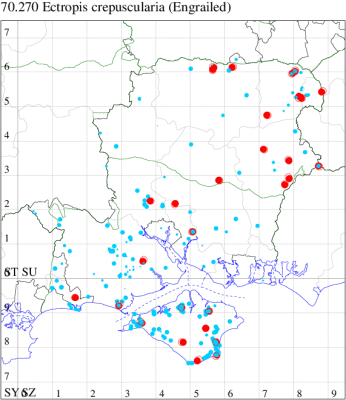
Records by year
Records by week (adult)
Records by week (larval)
Record Summary
VC10: Earliest: Freshwater, 20 Sep, 1 (PBa) Latest: Firestone Copse, 21 Jul, 1 (IOu) Max count: Shanklin, 01 Jul, 6 (IOu)
VC11: Earliest: Pig Bush, NF, 17 Jul, 1 (CL) Latest: Milford on Sea, 06 Sep, 1 (MMcM) Max count: Romsey, 23 Apr, 2 (SLay)
VC12: Earliest: Cholderton, 05 Sep, 1 (TJN, LF) Latest: Yateley, 23 Jun, 1 (JHH) Max count: Pamber Forest, 23 Jun, 2 (GJD)
70.272 [B&F: 1949] Square Spot Paradarisa consonaria (Hübner, [1799]) - Local
Local in broad-leaved woodland, scrub, parks and gardens throughout England, the main population centres being from Hampshire and the Isle of Wight to Kent, the Wye Valley and southern Cumbria. In our area, the main population centres are the central New Forest, Wickham Common / Botley Wood, and on the Isle of Wight, in the Cranmore / Ningwood Common area. Possibly declining in the north-east and around Chandlers Ford, where previously common. Wingspan 40-45 mm. The characteristic square-shaped blotch mid-way along the subterminal fascia is visible in most individuals, but obscured in some dark forms, which occur infrequently and which often have a pale central cross-band. Larva feeds on the foliage of Sessile and Pedunculate Oak, Silver and Downy Birch, Beech, Hornbeam and Yew; mid-June to mid-August, over-wintering as a pupa.
Records prior to 2020
| Vice County | #Records | #Individuals | First Record | Last Record |
|---|---|---|---|---|
| 10 | 55 | 63 | 1800 | 2019 |
| 11 | 301 | 257 | 1951 | 2019 |
| 12 | 129 | 120 | 1951 | 2019 |
2020 records
| Vice County | #Records | #Individuals | Max Quantity |
|---|---|---|---|
| 11 | 6 | 6 | 1 |
| 12 | 3 | 3 | 1 |
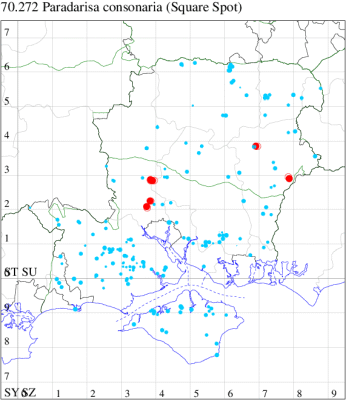
Records by year
Records by week (adult)
Records by week (larval)
Record Details
VC11: Romsey, one, 02 Jul (MB); one, 08 May (NRJ); Kings Somborne, one, to actinic, 21 May; one, to actinic, 21 May; one, to actinic, 11 Jun; Hursley, one, to actinic, 21 May (GCE);
VC12: Beech, one, 21 May; one, 19 Jul (NDP); Liss Forest, one, 17 Apr (RJM)
70.273 [B&F: 1950] Brindled White-spot Parectropis similaria (Hufnagel, 1767) - Local
Local in broad-leaved woodland, favouring ancient woodland in rural areas, occasionally in gardens throughout much of southern England and Wales. In Hampshire and on the Isle of Wight locally fairly common in deciduous woodland in all three vice-counties. Wingspan 33-39 mm. Fairly unmistakable. Larva feeds on Pedunculate Oak, Hazel, Hawthorn and Birch, over-wintering as a pupa.
Records prior to 2020
| Vice County | #Records | #Individuals | First Record | Last Record |
|---|---|---|---|---|
| 10 | 60 | 108 | 1800 | 2019 |
| 11 | 593 | 742 | 1951 | 2019 |
| 12 | 185 | 333 | 1951 | 2018 |
2020 records
| Vice County | #Records | #Individuals | Max Quantity |
|---|---|---|---|
| 10 | 2 | 2 | 1 |
| 11 | 5 | 6 | 2 |
| 12 | 2 | 4 | 3 |
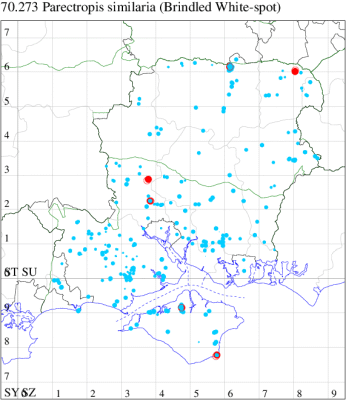
Records by year
Records by week (adult)
Records by week (larval)
Record Details
VC10: Parkhurst Forest, one, 29 Jun (IOu); Bonchurch, one, 25 May (JHa);
VC11: Kings Somborne, one, to actinic, 11 Jun (GCE); Romsey, two, 05 Jun (NRJ); Wickham, one, 17 Jun (JRDS);
VC12: Pamber Forest, three, 25 Jun (GJD); Yateley*, one, 26 May (JHH)
70.274 [B&F: 1951] Grey Birch Aethalura punctulata ([Denis & Schiffermüller], 1775) - Common
Common in birch woodland and heathland throughout Britain, most numerous in south-eastern England. Widespread and fairly common in Hampshire, but scarce on the Isle of Wight, with only one record so far this century. Wingspan 30-35 mm. Small size precludes confusion with all but Dotted Carpet Alcis jubata, which is whiter, with more conspicuous black marking, and Brussels Lace Cleorodes lichenaria, which has bolder, more strongly dentate subterminal fascia. Larva feeds on Downy and Silver Birch, and Alder, over-wintering as a pupa.
Records prior to 2020
| Vice County | #Records | #Individuals | First Record | Last Record |
|---|---|---|---|---|
| 10 | 15 | 7 | 1946 | 2007 |
| 11 | 468 | 392 | 1951 | 2019 |
| 12 | 184 | 232 | 1951 | 2019 |
2020 records
| Vice County | #Records | #Individuals | Max Quantity |
|---|---|---|---|
| 11 | 15 | 15 | 1 |
| 12 | 9 | 16 | 5 |
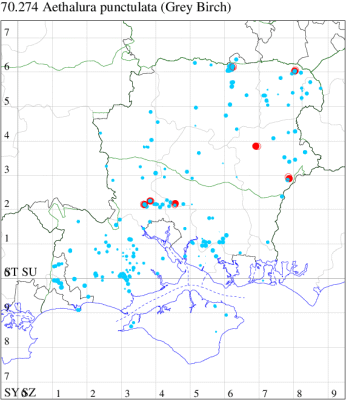
Records by year
Records by week (adult)
Records by week (larval)
Record Details
VC11: Romsey, one, 07 May; one, 14 May; one, 24 May (SLay); one, 18 Apr; one, 20 Apr; one, 21 Apr (NRJ); Allbrook, one, 09 May (SI); Wickham, one, 25 Apr; one, 19 May; one, 20 May; one, 21 May; one, 27 May; one, 07 Jun (JRDS); Sway, one, 07 May (SKe);
VC12: Beech, one, 25 May (NDP); Pamber Forest, one, 16 Apr; three, 07 May; five, 18 May; one, 20 May; one, 25 May (GJD); Liss Forest, one, 17 Apr (RJM); Yateley, two, 16 Apr; one, 09 May (JHH)
70.275 [B&F: 1952] Common Heath Ematurga atomaria (Linnaeus, 1758) - Common
Common on acid heathland, moorland, grassland, woodland rides and roadside verges throughout the British Isles. In Hampshire and on the Isle of Wight very common on the heaths of the New Forest and the north-east. Wingspan 22-34 mm. Day-flying. Very variable, but only likely to be confused with Latticed Heath Chiasmia clathrata, which see; in the south a large, yellow form sometimes occurs on chalk downland and in young plantations. Larva feeds on Red Clover, White Clover and Bird's-foot Trefoil, over-wintering as a pupa.
Records prior to 2020
| Vice County | #Records | #Individuals | First Record | Last Record |
|---|---|---|---|---|
| 10 | 7 | 4 | 1930 | 1981 |
| 11 | 885 | 1664 | 1951 | 2019 |
| 12 | 584 | 3733 | 1951 | 2019 |
2020 records
| Vice County | #Records | #Individuals | Max Quantity |
|---|---|---|---|
| 11 | 47 | 75 | 8 |
| 12 | 27 | 129 | 50 |
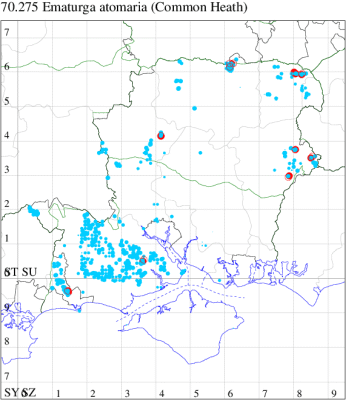
Records by year
Records by week (adult)
Records by week (larval)
Record Details
VC11: Ibsley Common, one, field observation, 30 May; Rockford Common, one, field observation, 30 May (MCur); Ibsley Common, one, field observation, 19 May (JHun); one, field observation, 08 Jun; Rockford Common, two, field observation, 07 Jun; one, field observation, 07 Jun (BWT); one, field observation, 30 May; one, field observation, 26 Jun (MCur); Vales Moor, one, field observation, 20 May (JoFre); one, field observation, 17 Jun (JaFre); one, field observation, 20 May (JoFre); Hasley, one, field observation, 08 Jun (JMah); Duckhole Bog, NF, one, field observation, 07 Jun; Wilverley Plain, two, field observation, 07 Jun; one, field observation, 07 Jun; two, field observation, 07 Jun; one, field observation, 07 Jun (RTay); Acres Down, NF, one, field observation, 19 May (JHun); Broomy Plain, one, field observation, 27 May; one, field observation, 27 May; eight, field observation, 27 May; Ocknell Plain, New Forest, three, field observation, 27 May; Broomy Plain, NF, one, field observation, 27 May (NOwe); one, field observation, 13 Jun (MWalk); Bramshaw Telegraph, NF, two, field observation, 01 Jun; Claypits Bottom, one, field observation, 01 Jun; one, field observation, 01 Jun (NOwe); Brockishill Winchester, one, field observation, 18 May; one, field observation, 13 Jun (JAda); Balmer Lawn, NF, one, field observation, 14 Jun (JGow); Perrywood Ivy Inclosure, Brockenhurst, NF, one, field observation, 19 May (JAda); Standing Hat, NF, one, field observation, 21 May (KBro); Hawkhill, one, field observation, 19 May (LHan); Beaulieu Heath North, NF, one, field observation, 15 Jun (DHan); Pig Bush, NF, two, 18 Jul (CL); King's Hat, NF, one, field observation, 02 Jun; Dibden Bottom, NF, two, field observation, 02 Jun (A&LB); Brockishill Winchester, one, field observation, 21 May (JAda); Sopley Common, one, field observation, 08 Jun; one, field observation, 08 Jun; Sopley Common DWT, three, field observation, 08 Jun (MDev); one, field observation, 22 Jun (RSte); Sopley Common, four, field observation, 08 Jun; six, field observation, 08 Jun (MDev); four, field observation, 22 Jun (RSte); Town Common, Christchurch, one, 10 May (MGo); St Catherine's Hill, Christchurch, one, 27 May (GTa);
VC12: Barton Stacey, two, field observation, 29 May (GCE); Pamber Forest, one, field observation, 18 May; two, field observation, 08 May; Silchester Common, two, field observation, 08 May (GJD); 12, 14 Jun (JLe); Longmoor Camp, Greatham, two, 07 Jun (DAS); Liss Forest, present, 08 May; present, 09 May (iNat); Broxhead Common, two, field observation, 18 May; one, field observation, 18 May; one, field observation, 18 May; one, field observation, 21 May; one, field observation, 21 May; one, field observation, 21 May (AGre); five, field observation, 15 May; 10, field observation, 12 Jun; one, field observation, 26 Jun (KBW); Conford Moor, five, field observation, 07 Jun (RAll); Ludshott Common, 50, field observation, 21 May; 10, field observation, 26 May (KBW); Bramshott Common, two, field observation, 05 May; five, field observation, 07 May; three, field observation, 18 May; one, field observation, 20 May; three, field observation, 31 May (AGre); Yateley, present, 01 May (JHH); Blackbushe Airfield, one, field observation, 24 Jun; Yateley Common, 10, field observation, 29 May (KBW)
70.276 [B&F: 1954] Bordered White Bupalus piniaria (Linnaeus, 1758) - Common
Common in coniferous woodland and plantations throughout much of the British Isles. In Hampshire and on the Isle of Wight fairly common in pine woodland in all three vice-counties, though apparently never the pest it sometimes is in other parts of the country. Wingspan 34-40 mm. Unmistakable. Larva feeds on Scots Pine, Corsican Pine, Norway Spruce and European Larch, causing sufficient damage to be a serious pest in some areas, over-wintering as a pupa.
Records prior to 2020
| Vice County | #Records | #Individuals | First Record | Last Record |
|---|---|---|---|---|
| 10 | 61 | 78 | 1856 | 2017 |
| 11 | 713 | 573 | 1951 | 2019 |
| 12 | 169 | 210 | 1951 | 2019 |
2020 records
| Vice County | #Records | #Individuals | Max Quantity |
|---|---|---|---|
| 11 | 7 | 6 | 1 |
| 12 | 8 | 10 | 3 |
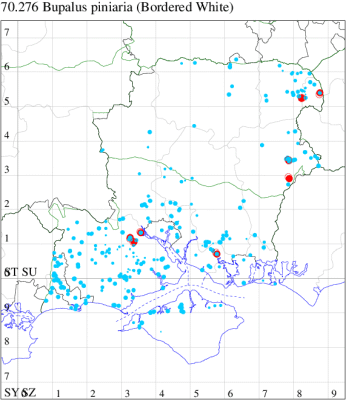
Records by year
Records by week (adult)
Records by week (larval)
Record Details
VC11: Woodlands, New Forest, present, 24 Jun (RBW); Ashurst, NF, one, 17 Apr; one, 24 Jun (SAB); Totton, one, 26 May (LH); Fareham, one, ♂, 01 Jun (KJW); Wickham, one, 22 Jun (JRDS);
VC12: Warren Hill, Liss Forest, one, 20 Jun; one, field observation, 20 Jun (RJM); Whitehill, one, to actinic, 01 Jun; one, to actinic, 15 Jun; three, to actinic, 25 Jun (ASto); Church Crookham, one, to actinic, 25 May (DDim); Farnborough, one, 25 Jun (KBW)
70.277 [B&F: 1955] Common White Wave Cabera pusaria (Linnaeus, 1758) - Common
Common in woodland, scrub and gardens throughout the British Isles. Widespread and common in Hampshire and on the Isle of Wight. Wingspan 32-35 mm. The main confusion species is Common Wave C. exanthemata, in which cross-lines are brown and curved. Larva feeds on Downy and Silver Birch, Alder and Sallow, over-wintering as a pupa.
Records prior to 2020
| Vice County | #Records | #Individuals | First Record | Last Record |
|---|---|---|---|---|
| 10 | 389 | 541 | 1951 | 2019 |
| 11 | 4596 | 5481 | 1951 | 2019 |
| 12 | 1488 | 1734 | 1951 | 2019 |
2020 records
| Vice County | #Records | #Individuals | Max Quantity |
|---|---|---|---|
| 10 | 36 | 76 | 11 |
| 11 | 101 | 123 | 3 |
| 12 | 59 | 82 | 5 |
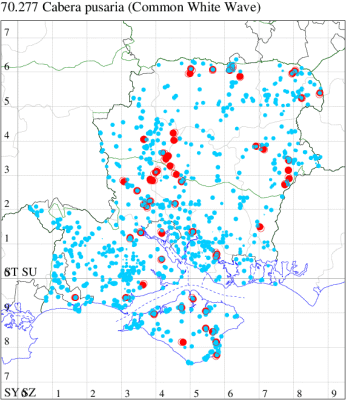
Records by year
Records by week (adult)
Records by week (larval)
Record Summary
VC10: Earliest: Cranmore, 02 Jun, 0 (CHic) Latest: Sandpit Copse, 20 May, 1 (IOu) Max count: Haseley Manor, 09 Jun, 11 (IOu)
VC11: Earliest: Woodlands, New Forest, 03 Jun, 0 (RBW) Latest: Norleywood, NF, 09 Aug, 0 (RBW, MWa) Max count: Southampton, 08 Jun, 3 (MEdg)
VC12: Earliest: Cholderton, 17 Jul, 1 (TJN, HE) Latest: Yateley, 23 Jun, 1 (JHH) Max count: Pamber Forest, 07 Aug, 5 (GJD)
70.278 [B&F: 1956] Common Wave Cabera exanthemata (Scopoli, 1763) - Common
Common in broad-leaved, often damp, woodland throughout much of the British Isles; frequently recorded and well distributed across Hampshire and the Isle of Wight. Wingspan 30-35 mm. The main confusion species is Common White Wave C. pusaria, in which the cross-lines are straight and grey. Larva feeds on Goat Willow, Grey Willow, Aspen and Poplar, over-wintering as a pupa.
Records prior to 2020
| Vice County | #Records | #Individuals | First Record | Last Record |
|---|---|---|---|---|
| 10 | 603 | 860 | 1856 | 2019 |
| 11 | 4797 | 6120 | 1951 | 2019 |
| 12 | 1229 | 1551 | 1951 | 2019 |
2020 records
| Vice County | #Records | #Individuals | Max Quantity |
|---|---|---|---|
| 10 | 43 | 72 | 9 |
| 11 | 153 | 190 | 5 |
| 12 | 38 | 41 | 2 |
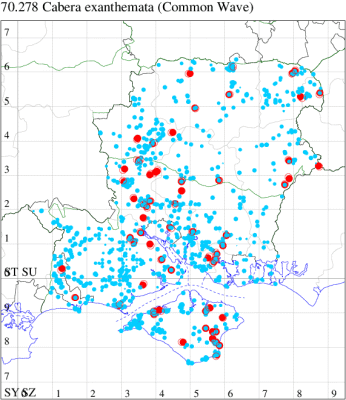
Records by year
Records by week (adult)
Records by week (larval)
Record Summary
VC10: Earliest: Cranmore, 01 Aug, 0 (CHic) Latest: Firestone Copse, 08 May, 2 (KShw) Max count: Haseley Manor, 11 Aug, 9 (IOu)
VC11: Earliest: Brockwood, 19 Jun, 1 (SDut) Latest: Norleywood, NF, 09 Aug, 0 (RBW, MWa) Max count: Wickham, 16 Aug, 5 (JRDS)
VC12: Earliest: Cholderton, 31 Jul, 1 (TJN, HE) Latest: Yateley, 17 Aug, 1 (JHH) Max count: Anna Valley, Andover, 26 May, 2 (TJN)
70.279 [B&F: 1957] White-pinion Spotted Lomographa bimaculata (Fabricius, 1775) - Common
Common in woodland, scrub, hedgerows and gardens throughout England and Wales, less frequently, but increasingly, in the north. Widespread and fairly common in Hampshire and on the Isle of Wight. Wingspan 27-31 mm. Can be confused with very faded examples of Green Carpet Colostygia pectinataria. Larva feeds on Blackthorn and Hawthorn, over-wintering as a pupa.
Records prior to 2020
| Vice County | #Records | #Individuals | First Record | Last Record |
|---|---|---|---|---|
| 10 | 153 | 269 | 1900 | 2019 |
| 11 | 689 | 723 | 1948 | 2019 |
| 12 | 300 | 338 | 1951 | 2019 |
2020 records
| Vice County | #Records | #Individuals | Max Quantity |
|---|---|---|---|
| 10 | 5 | 5 | 1 |
| 11 | 2 | 2 | 1 |
| 12 | 6 | 7 | 2 |
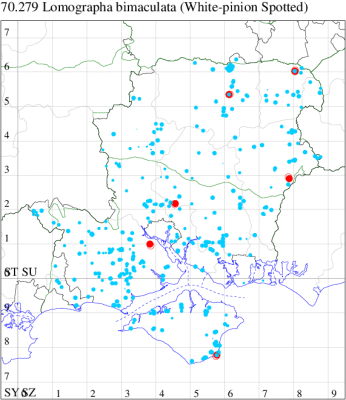
Records by year
Records by week (adult)
Records by week (larval)
Record Details
VC10: Bonchurch, one, 25 May; one, 26 May; one, 27 May; one, 08 Jun; one, 15 Jun (JHa);
VC11: Marchwood, two, 29 Jul (CTh); Allbrook, one, 26 May (SI);
VC12: Basingstoke, one, 27 May (MJW); Liss Forest, one, 04 May; one, 14 Jun (RJM); Yateley, one, 16 Jun; two, 26 May; one, 23 Jun (JHH)
70.280 [B&F: 1958] Clouded Silver Lomographa temerata ([Denis & Schiffermüller], 1775) - Common
Common in woodland, scrub, hedgerows, parks and gardens throughout England, Wales and southern Scotland. Widespread and common in Hampshire and on the Isle of Wight. Wingspan 27-34 mm. Larva feeds on Hawthorn, Blackthorn, Plum, Wild Cherry and Crab Apple, over-wintering as a pupa.
Records prior to 2020
| Vice County | #Records | #Individuals | First Record | Last Record |
|---|---|---|---|---|
| 10 | 739 | 1585 | 1879 | 2019 |
| 11 | 3245 | 4180 | 1951 | 2019 |
| 12 | 1422 | 2356 | 1951 | 2019 |
2020 records
| Vice County | #Records | #Individuals | Max Quantity |
|---|---|---|---|
| 10 | 33 | 70 | 10 |
| 11 | 88 | 99 | 4 |
| 12 | 61 | 88 | 6 |
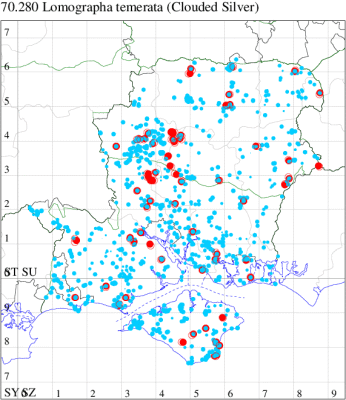
Records by year
Records by week (adult)
Records by week (larval)
Record Summary
VC10: Earliest: Kingston, 17 Jun, 2 (ENes) Latest: Broadley Copse, 25 Jun, 1 (JBa) Max count: Kingston, 24 Jun, 10 (ENes)
VC11: Earliest: Furze Hill, NF, 19 Jul, 0 (RBW, MWa) Latest: Pilley Bailey, NF, 07 Jul, 1 (RBW, MWa) Max count: Allbrook, 24 Jun, 4 (SI)
VC12: Earliest: Over Wallop, 21 May, 2 (CM) Latest: Yateley, 23 Jun, 1 (JHH) Max count: Barton Stacey, 08 Jun, 6 (GCE)
70.282 [B&F: 1960] Early Moth Theria primaria (Haworth, 1809) - Common
Common in open woodland, woodland edges, scrub and mature hedgerows throughout England, Wales and southern Scotland. In Hampshire and on the Isle of Wight common to abundant in late winter amongst hawthorn in open country and on the downs. Wingspan male 32-37 mm, female wingless. Males could be confused with Sloe Carpet Aleucis distinctata, but Early Moth has straighter distal edge of central band and females have band on vestigial wings. The flightless females may be found sitting on the leafless twigs after dark. Larva feeds on Blackthorn, Hawthorn and Midland Hawthorn.
Records prior to 2020
| Vice County | #Records | #Individuals | First Record | Last Record |
|---|---|---|---|---|
| 10 | 115 | 221 | 1978 | 2019 |
| 11 | 325 | 447 | 1951 | 2019 |
| 12 | 306 | 393 | 1951 | 2019 |
2020 records
| Vice County | #Records | #Individuals | Max Quantity |
|---|---|---|---|
| 10 | 1 | 0 | 0 |
| 11 | 4 | 4 | 1 |
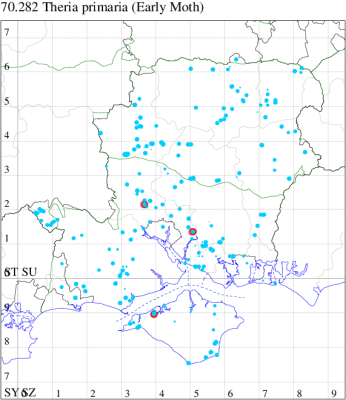
Records by year
Records by week (adult)
Records by week (larval)
Record Details
VC10: Cranmore, present, to actinic, 24 Jan (CHic);
VC11: Romsey, one, 27 Mar (SLay); Botley, one, to actinic, 12 Feb; one, to actinic, 12 Feb; one, to actinic, 14 Feb (SLB)
70.283 [B&F: 1961] Light Emerald Campaea margaritaria (Linnaeus, 1761) - Common
Common in broad-leaved woodland, areas with scattered trees, scrub, hedgerows, parks and gardens throughout the British Isles. Widespread and common in Hampshire and on the Isle of Wight. Wingspan 42-54 mm. Larva feeds on Pedunculate Oak, Hawthorn, Blackthorn, Hazel, Downy and Silver Birch, Elm, Sallow, Horse Chestnut, Sweet Chestnut and Beech.
Records prior to 2020
| Vice County | #Records | #Individuals | First Record | Last Record |
|---|---|---|---|---|
| 10 | 1099 | 2568 | 1951 | 2019 |
| 11 | 10886 | 19791 | 200 | 2019 |
| 12 | 2552 | 4920 | 1951 | 2019 |
2020 records
| Vice County | #Records | #Individuals | Max Quantity |
|---|---|---|---|
| 10 | 135 | 528 | 20 |
| 11 | 739 | 1453 | 20 |
| 12 | 310 | 896 | 34 |
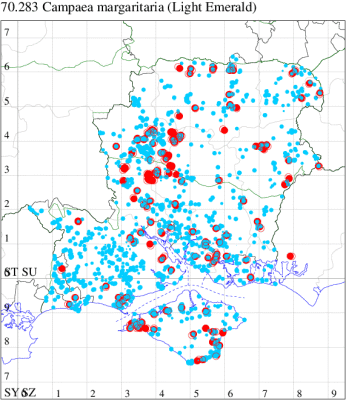
Records by year
Records by week (adult)
Records by week (larval)
Record Summary
VC10: Earliest: West High Down Quarry, 20 Aug, 6 (IOu) Latest: Sandpit Copse, 20 May, 7 (IOu) Max count: Freshwater Bay, 20 Sep, 20 (SDa)
VC11: Earliest: Brockwood, 23 May, 1 (SDut) Latest: Pennington, 22 Sep, 1 (RFC) Max count: Wickham, 14 Sep, 20 (JRDS)
VC12: Earliest: Over Wallop, 27 Aug, 2 (CM) Latest: Yateley, 08 Sep, 14 (JHH) Max count: Pamber Forest, 30 May, 34 (GJD)
70.284 [B&F: 1962] Barred Red Hylaea fasciaria (Linnaeus, 1758) - Common
Common wherever there are coniferous trees throughout the British Isles. Widespread and fairly common in Hampshire and on the Isle of Wight. Wingspan 32-44 mm. Occasional green individuals of the form f. prasinaria, which can be confused with Light Emerald Campaea margaritata, are reported. Larva feeds on various coniferous trees, including Scots Pine, Norway Spruce and European Larch.
Records prior to 2020
| Vice County | #Records | #Individuals | First Record | Last Record |
|---|---|---|---|---|
| 10 | 79 | 60 | 1856 | 2019 |
| 11 | 1216 | 1237 | 1951 | 2019 |
| 12 | 328 | 410 | 1951 | 2019 |
2020 records
| Vice County | #Records | #Individuals | Max Quantity |
|---|---|---|---|
| 10 | 8 | 7 | 1 |
| 11 | 27 | 27 | 2 |
| 12 | 20 | 25 | 3 |
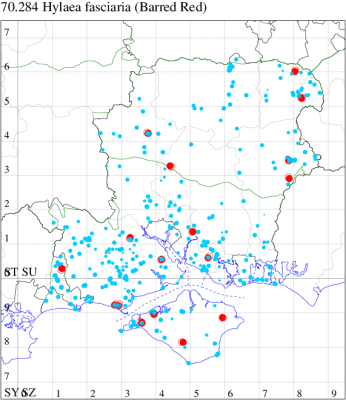
Records by year
Records by week (adult)
Records by week (larval)
Record Details
VC10: Freshwater, one, to actinic, 18 Sep; one, to actinic, 19 Sep; one, to actinic, 18 Sep; one, to actinic, 14 Sep; one, to actinic, 15 Sep (PBa); Cranmore, present, to actinic, 11 Sep (CHic); Kingston, one, 24 Jun (ENes); Broadley Copse, one, to actinic, 25 Jun (JBa);
VC11: Brockwood, one, 19 Jun (SDut); Woodlands, New Forest, present, 08 Jun (RBW); Dibden Purlieu, one, to actinic, 02 Aug; one, to actinic, 23 Jun (RAC); Eastleigh, one, to actinic, 21 May (KArb); Catisfield, one, 15 Jun; one, 23 Jun; one, 24 Jun (ALR); Botley, one, to actinic, 19 Jun (SLB); Wickham, one, 22 Jun (JRDS); Lovedean, one, 10 Jun (ARJ); Northney, Hayling Island, present, 21 Jun (JWP); Petersfield, one, to actinic, 13 Jul (RAll); Sway, one, 08 Jun; one, 17 Jun; one, 24 Jun; one, 25 Jun (SKe); Milford on Sea, two, 27 Jul; one, 14 Jul; one, 17 Jul; two, 31 Jul (MMcM);
VC12: Goodworth Clatford, one, to actinic, 24 Jun; two, to actinic, 24 Jun; Crawley, three, to actinic, 30 Jun (GCE); Liss Forest, two, 21 May; one, 25 May; one, 20 Jun; two, 01 Aug (RJM); Whitehill, one, to actinic, 24 May; one, to actinic, 27 May; one, to actinic, 01 Jun; one, to actinic, 13 Jun; one, to actinic, 17 Jun; one, to actinic, 19 Jun; two, to actinic, 25 Jun; one, to actinic, 07 Jul (ASto); Headley, Bordon, present, 22 Jun (iNat); Church Crookham, one, to actinic, 24 May; one, to actinic, 27 May (DDim); Yateley*, one, 26 May (JHH)
70.287 [B&F: 1964] Annulet Charissa obscurata ([Denis & Schiffermüller], 1775) - Local
Local on heathland, moorland, calcareous grassland, sea cliffs and quarries throughout much of the British Isles. In Hampshire and on the Isle of Wight local and uncommon; on the heaths of the New Forest, a dark form predominates, and on the Freshwater cliffs, a quite different, white, form is found. Wingspan 32-39 mm. In their corresponding ranges, could be confused with Irish Annulet Odontognophos dumetata or Scotch Annulet Gnophos obfuscata, which see for a description of the differences. Larva feeds on Sea Campion, Thrift, Common Rock-rose, Common Bird's-foot Trefoil, Kidney Vetch, Creeping Cinquefoil, Wild Strawberry, Wild Thyme, Salad Burnet and Heather.
Records prior to 2020
| Vice County | #Records | #Individuals | First Record | Last Record |
|---|---|---|---|---|
| 10 | 61 | 88 | 1856 | 2019 |
| 11 | 60 | 39 | 1945 | 2018 |
| 12 | 11 | 11 | 1951 | 2012 |
2020 records
| Vice County | #Records | #Individuals | Max Quantity |
|---|---|---|---|
| 10 | 2 | 2 | 1 |
| 11 | 4 | 4 | 1 |
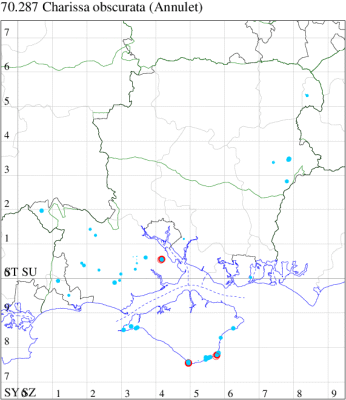
Records by year
Records by week (adult)
Records by week (larval)
Record Details
VC10: Windy Corner, one, 14 Sep (IOu); Bonchurch, one, 10 Aug (JHa);
VC11: Dibden Purlieu, one, to actinic, 08 Aug; one, to actinic, 13 Aug (RAC)
70.288 [B&F: 1945] Brussels Lace Cleorodes lichenaria (Hufnagel, 1767) - Local
Local in scrub, woodland, plantations and rocky areas by the sea, in south-west England, west Wales and the west coast of Scotland, also in a few places in central and southern England. In Hampshire and on the Isle of Wight this species all but disappeared in the second half of the 1940s, but has increased dramatically in the last few years, and is now to be found throughout the New Forest, in the Test Valley around Leckford and Chilbolton, and on the Isle of Wight. Wingspan 31-38 mm. Fairly unmistakable. Larva feeds on various lichens.
Records prior to 2020
| Vice County | #Records | #Individuals | First Record | Last Record |
|---|---|---|---|---|
| 10 | 612 | 1308 | 1800 | 2019 |
| 11 | 1117 | 1646 | 1948 | 2019 |
| 12 | 284 | 493 | 1948 | 2019 |
2020 records
| Vice County | #Records | #Individuals | Max Quantity |
|---|---|---|---|
| 10 | 62 | 180 | 15 |
| 11 | 161 | 250 | 11 |
| 12 | 42 | 60 | 4 |
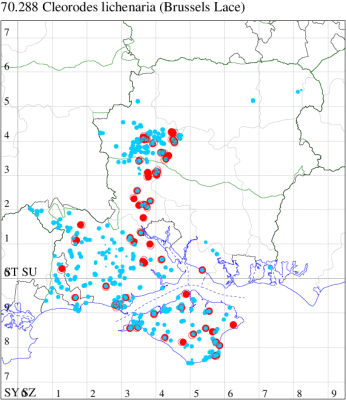
Records by year
Records by week (adult)
Records by week (larval)
Record Summary
VC10: Earliest: West High Down Quarry, 07 Aug, 15 (IOu) Latest: Bembridge Fort, 06 Aug, 1 (IOu) Max count: West High Down Quarry, 07 Aug, 15 (IOu)
VC11: Earliest: Brockwood, 27 May, 1 (SDut) Latest: Pilley Bailey, NF, 03 Aug, 2 (RBW, MWa) Max count: Titchfield Haven NNR, 17 Jul, 11 (F.M.G.)
VC12: Earliest: Cholderton, 10 Jul, 2 (TJN, HE) Latest: Barton Stacey, 22 Jun, 1 (GCE) Max count: Cholderton, 17 Jul, 4 (TJN, HE)
70.292 [B&F: 1969] Grey Scalloped Bar Dyscia fagaria (Thunberg, 1784) - Local
Local on heathland, moorland, bogs and mosses throughout much of the British Isles. In Hampshire locally rather frequent on the New Forest heaths, especially near recently burned ground, on which the imago rests by day; very occasional elsewhere in the county and on the Isle of Wight, where first recorded in 2001. Wingspan 31-40 mm. Larva feeds on Heather, Bell Heather and Cross-leaved Heath.
Records prior to 2020
| Vice County | #Records | #Individuals | First Record | Last Record |
|---|---|---|---|---|
| 10 | 1 | 1 | 2001 | 2001 |
| 11 | 95 | 72 | 1800 | 2016 |
| 12 | 9 | 1 | 1951 | 1981 |
2020 records
| Vice County | #Records | #Individuals | Max Quantity |
|---|---|---|---|
| 11 | 1 | 1 | 1 |
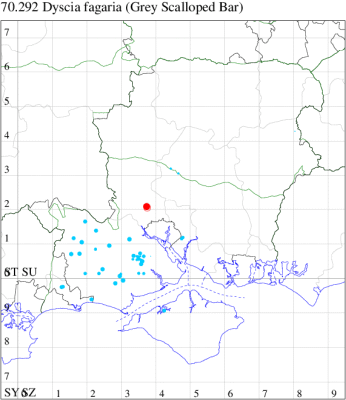
Records by year
Records by week (adult)
Records by week (larval)
Record Details
VC11: Romsey*, one, 04 May (MB)
70.294 [B&F: 1968] Yellow Belle Aspitates ochrearia (Rossi, 1794) - Local
Local on sand-dunes, shingle beaches, saltmarshes, golf courses and heathland, along the coasts of southern England, predominantly coastal. In Hampshire and on the Isle of Wight frequent on dunes and shingle in coastal localities, rare inland on the chalk. Wingspan 28-36 mm. The most likely confusion species is Straw Belle Aspitates gilvaria, but Yellow Belle has a more rounded forewing and more distinct antemedian fascia. Larva feeds on Sea Wormwood, Hare's-foot Clover, Smooth Tare, Bird's-foot Trefoil, Common Restharrow, Wild Carrot and Beaked Hawk's-beard.
Records prior to 2020
| Vice County | #Records | #Individuals | First Record | Last Record |
|---|---|---|---|---|
| 10 | 115 | 78 | 1856 | 2019 |
| 11 | 511 | 593 | 1945 | 2019 |
| 12 | 10 | 12 | 1945 | 2016 |
2020 records
| Vice County | #Records | #Individuals | Max Quantity |
|---|---|---|---|
| 10 | 12 | 19 | 5 |
| 12 | 1 | 1 | 1 |
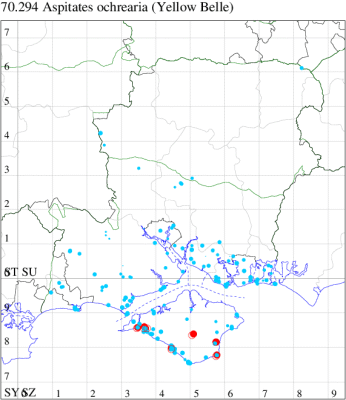
Records by year
Records by week (adult)
Records by week (larval)
Record Details
VC10: Freshwater Cliffs, one, 30 Aug (SDa); Compton, five, field observation, 21 May (ABu); Compton Down, two, to actinic, 13 Sep; one, to actinic, 14 Sep (PBa); Atherfield, one, field observation, 15 May; three, field observation, 20 May (ABu); Bonchurch, one, 25 May; one, 29 May (JHa); Rookley, one, to actinic, 09 May; one, to actinic, 19 May; one, 07 Jul (JBa); Shanklin, one, 19 May (IOu);
VC12: Old Down, Basingstoke*, one, field observation, 15 Sep (JLin)
70.295 [B&F: 1970] Grass Wave Perconia strigillaria (Hübner, [1787]) - Local
Local on heathland, open woodland, moorland and bogs throughout the British Isles. In Hampshire fairly common on the heaths of the New Forest and in the north-east, but very local elsewhere. Not recorded from the Isle of Wight since 1948. Wingspan 36-41 mm. The most likely confusion species is Common Heath Ematurga atomaria, especially pale forms. Larva feeds on Heather, Bell Heather, Broom and Petty Whin.
Records prior to 2020
| Vice County | #Records | #Individuals | First Record | Last Record |
|---|---|---|---|---|
| 10 | 1 | 1 | 1948 | 1948 |
| 11 | 367 | 462 | 1800 | 2019 |
| 12 | 111 | 170 | 1951 | 2019 |
2020 records
| Vice County | #Records | #Individuals | Max Quantity |
|---|---|---|---|
| 12 | 2 | 6 | 5 |
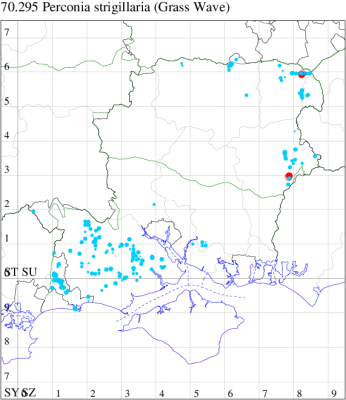
Records by year
Records by week (adult)
Records by week (larval)
Record Details
VC12: Longmoor Camp, Greatham, five, 07 Jun (DAS); Yateley Common, one, field observation, 29 May (KBW)
()().jpg)